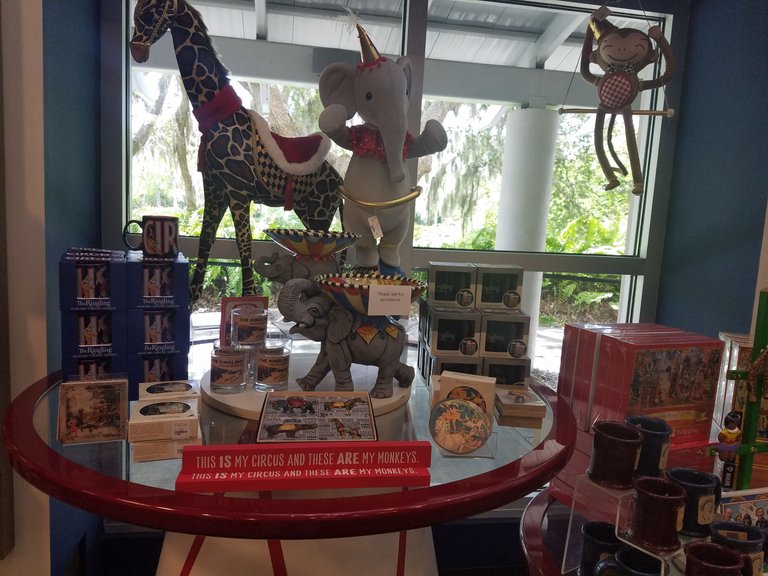Hey there!
This is the fourth and final post about my visit to Sarasota, Florida during the Summer of 2024:
A1: Sarasota Overview & South Lido Key Beach
A2: Mote Marine Laboratory & Aquarium and Save Our Seabirds Wild Bird Learning Center
A3: Marie Selby Botanical Gardens
A4: The Ringling, Museum of Art, Bayfront Gardens, Ca' d'Zan, and Circus Museum (this post)
This post covers the four main parts of The Ringling. The Ringling was the estate of John and Mable Ringling, John being known from the Ringling Brothers Circus which later became the Ringling Bros. and Barnum & Bailey Circus. After his death, he willed his house (Ca' d'Zan, Venetian for "House of John"), the museum, and his art collection to the state of Florida. All of the pictures in this post were taken by me except for the one map of the estate grounds.
THE RINGLING
5401 Bay Shore Road
Sarasota, FL 34243
I believe the Sarasota County Area Transit (SCAT) system has several bus routes that are close by. Routes 2 and 99 have a stop at [N Tamiami Trl @ General Spaatz Blvd] and also stop by the airport. Route 99 also stops by [N Tamiami Trl @ University Pkwy]. The Manatee County Area Transit's Route 99 also makes these stops as well.
Website: https://www.ringling.org/
Hours: Open Daily, 10 A.M. — 5 P.M.
On Thursdays, the Museum of Art and Bayfront Gardens are also open later, until 8 PM.
Cost (as of 2024):
There are four main areas. Most of the packages are bundles.
Note that there IS a student discount (which is not shown on the website because it needs to be bought in person).
Parking is free.
Bayfront Gardens:
If you only want to visit the gardens, then it is $5 for Adults and Free for children under 17.
Most other packages include the Bayfront Gardens.
Access to the Bayfront Gardens and the Museum of Art is FREE on Mondays.
Museum of Art:
Most of the ticket packages on the website bundle the Museum of Art with the Circus Museum.
From the website, access to the Museum of Art, Circus Museum, and Bayfront Gardens bundled together is (does not include the Ca' d'Zan):
Adult: $30
Age 6-17: $5
Under 6: Free
Access to the Bayfront Gardens and the Museum of Art is FREE on Mondays. This was a special stipulation when John Ringling bequeathed his estate to the people of Florida.
You can also get discounted access to the Bayfront Gardens and Museum of Art on Thursday from 5 PM - 8 PM:
Adult: $15
Age 6-17: $5
Under 6: Free
Circus Museum:
You cannot buy a la carte access to just the Circus Museum. It is always bundled into one of the larger packages. The cheapest package (which includes access to both museums and the gardens) is:
Adult: $30
Age 6-17: $5
Under 6: Free
If you visit on a Monday (when the Bayfront Gardens and Museum of Art is free) but want to also see the Circus Museum, you have to buy a normal ticket.
Ca' d'Zan:
There are three different ticket options for seeing the Ca' d'Zan.
#1. Bayfront Gardens + Museum of Art + Circus Museum + self-guided visit through Ca' d'Zan's first floor
Adult: $40
Age 6-17: $15
Under 6: $10
Member: Free
This is the ticket that I bought. Compared to the ticket that doesn't include the Ca' d'Zan ($30), you are essentially paying $10 for access to the first floor.
#2. Bayfront Gardens + Museum of Art + Circus Museum + guided tour of the Ca' d'Zan's first and second floors
Adult: $55
Age 6-17: $30
Under 6: $25
Member: $10
#3. Guided tour of all floors of the Ca' d'Zan including the Belvedere Tower. Includes access to the Bayfront Gardens but does NOT include museum admission.
$60 per person
Member: $25
Estimated Time:
Bayfront Gardens: 30 - 60 minutes
Museum of Art: 1 - 2 hours
Circus Museum: 2 - 4 hours
Ca' d'Zan: 20 - 30 minutes exploring the first floor on your own. The first floor audio guide is about 16.5 minutes. The guided tours are 40 and 70 minutes long.
I spent a total of 4.5 hours at the Ringling. There wasn't too much to see in the gardens and I did a thorough walk through the Museum of Art. The Ca' d'Zan took less time than I expected and I even went through it twice. I spent the most time at the Circus Museum and there was a wealth of information to learn about and read. I probably read about 75% of it. I wouldn't have minded spending a few more hours at the Circus Museum.
SUMMARY
While most of the Sarasota attractions I went to (Mote Aquarium and Selby Gardens) could be thoroughly viewed in 2 hours, the Ringling is something you could easily spend the whole day on.
The Ringling is conveniently located right next to Sarasota-Bradenton airport, making it the perfect place to spend a few hours before making your flight. In fact, since admission to the gardens and the art museum is free on Monday, if you're going home after a weekend in Sarasota, you might want to consider taking an afternoon or evening flight on Monday so that you can spend a few hours at the Ringling. I left my luggage in my rental car but if you pack light you can take it with you.
Overall I would give the Ringling 4 stars if you look at all four parts as a whole. In fact, one of the best features is that you get access to so many types of attractions (gardens, art, history, architecture) all in one location.
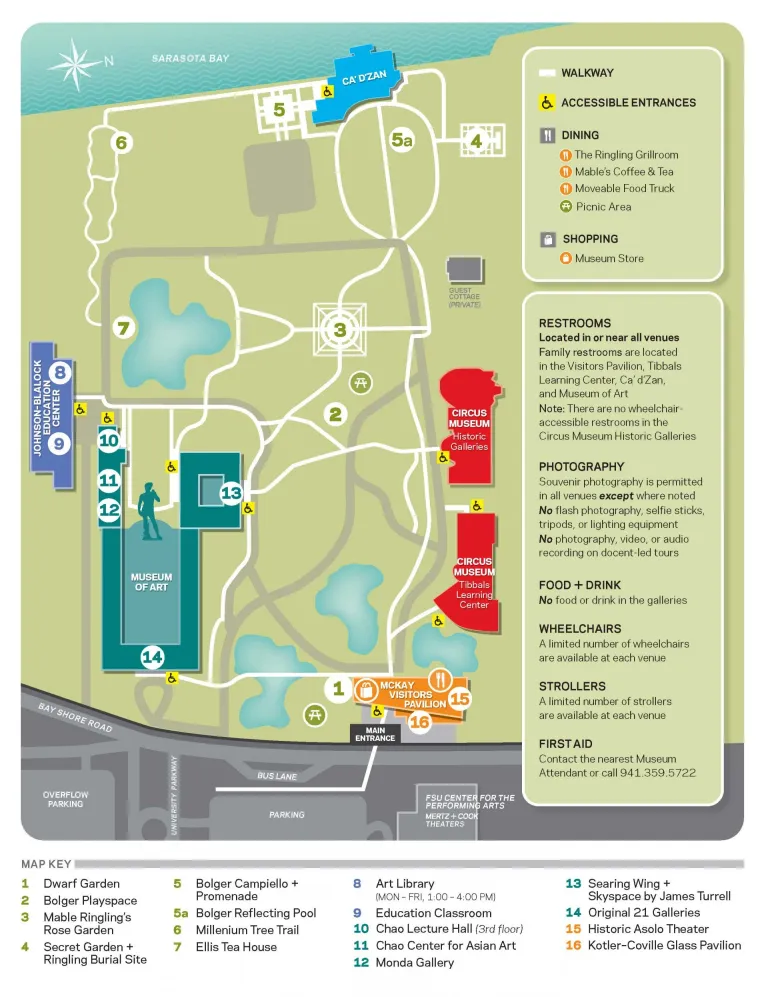
If you want to look at each part individually:
Bayfront Gardens I would rate as 2 stars. You can walk around and view some gardens but there isn't too much to see or do.
5 stars: Sydney and Walda Besthoff Sculpture Garden (New Orleans, Free)
4 stars: Marie Selby Botanical Gardens (Sarasota), Morton Arboretum (Chicago suburbs)
3 stars: Jardin at the Monastère de Cimiez (Nice, France, Free), Villa del Principe (Genoa, Italy)
2 stars: Millennium Park (Chicago, Free), Centennial Olympic Park (Atlanta, Free)
For museums, I would rate the Circus Museum at 4 stars and the Museum of Art at 3 stars. I think the Circus Museum is definitely the most interesting part of The Ringling and the area I spent the most time in. There are lots of interesting sights, artifacts, and informational tidbits.
5 stars:
- Field Museum (Chicago)
- Art Institute of Chicago (Chicago)
- Sydney and Walda Besthoff Sculpture Garden (New Orleans, Free)
- Castello Sforzesco (Milan, Italy)
4 stars:
- Museum of Science and Industry (Chicago)
- CDC Museum (Atlanta, Free)
- Mardi Gras World (New Orleans)
- World War 2 Museum (New Orleans)
- Museum d'Histoire Naturelle (Nice, France) (2 stars without the Lego special exhibit)
- Musée des Beaux-Arts de Nice (Nice, France)
- Musée Masséna (Nice, France)
- Musei di Strada Nuova (Genoa, Italy)
- Galata Museo del Mare (Genoa, Italy)
- Villa del Principe (Genoa, Italy)
- Museo del Duomo (Milan, Italy)
- Pinacoteca Ambrosiana (Milan, Italy)
3 stars:
- Chicago Fed Money Museum (Chicago, Free)
- Medieval Torture Museum (Chicago)
- Michael C Carlos Museum (Atlanta)
- Center for Puppetry Arts (Atlanta)
- High Museum of Art (Atlanta)
- Fernbank Museum of Natural History (Atlanta)
- New Orleans Museum of Art (New Orleans)
- Musée d'Archéologie de Nice-Cimiez (Nice, France)
- Musée Matisse (Nice, France)
- Palais Lascaris (Nice, France)
- Musée Picasso (Antibes, France)
- Museo Diocesano (Genoa, Italy)
- Civico Museo Archeologico (Milan, Italy)
- Museo Nazionale della Scienza e della Tecnologia Leonardo da Vinci (Milan, Italy)
- Museo di Storia Naturale (Milan, Italy)
2 stars:
- Museum of Contemporary Photography (Chicago, Free)
- Design Museum of Chicago (Chicago, Free)
- Museum of Illusions (Atlanta)
- Atlanta History Center (Atlanta)
- Musée de la Photographie Charles Nègre (Nice, France)
- L'artistique (Nice, France, Free)
- Musée d'Archéologie d'Antibes (Antibes, France)
- Musée Peynet et du Dessin Humoristique (Antibes, France)
- Museo Civico di Storia Naturale Giacomo Doria (Genoa, Italy)
- Museo del Tesoro di San Lorenzo (Genoa, Italy)
- Museo Biblioteca dell'Attore (Genoa, Italy, Free)
- Museo di Sant'Agostino (Genoa, Italy)
- Museo del Novecento (Milan, Italy)
1 star:
- National Center for Civil and Human Rights (Atlanta)
For the Ca' d'Zan, I would just rate it at 2 stars. It has beautiful architecture and luxurious furnishings, but I just don't think it's worth the premium price for the short amount of time it takes to go through it.
4 stars: Winchester Mystery House (San Jose), Chicago Cultural Center (Chicago, Free)
3 stars: Swan House (Atlanta)
2 stars: The Rookery (Chicago, Free), Monastère de Cimiez (Nice, France, Free), Duomo di Milano (Genoa, Italy)
1 star: Willis/Sears Tower Skydeck
MUSEUM OF ART
I really like how the Ringling Museum of Art has detailed descriptions of the artwork. This helps you learn more as you browse the galleries (the italics below are the descriptive details provided by the museum). Here are some of my favorite pieces that I saw:
The Emperor Justinian, 1886
Oil on canvas
Jean Joseph Benjamin Constant
French, 1845 - 1902
Dimensions: 148 x 260 in. (375.9 x 660.4 cm)
The massive scale of this painting is no accident: by submitting such a large work to the Paris Salon of 1886, Benjamin-Constant hoped to finally win a grand medal. Wishing to create an authentic setting for this imagined scene from the 6th century, he copied costumes and jewelry from ancient sources, laboring over every detail. Unfortunately, despite receiving extensive admiration in the press, the painting was considered overly decorative and did not win the medal.
Justinian I, also called Justinian the Great, was the Eastern Roman (Byzantine) emperor from 527 to 565. He is best known for his efforts to strengthen the empire and to standardize Roman law. In this scene, Justinian, wearing the imperial crown, is seated on a marble throne, with his counselors on benches to either side. In the foreground, a seated man in a hairshirt unfurls a scroll bearing a Greek text. The passage, which is mostly legible, is from the end of St. Paul’s epistle to Titus. Whether this text has a specific meaning here, or was included simply to give the painting an authentic look, remains unclear.
"Emperor Justinian" was purchased from Benjamin-Constant by an American collector, who donated it to the Metropolitan Museum of Art in 1890. It was prominently displayed there until 1908, returned to the donor’s family in 1928, and in the following year purchased by John Ringling. Though it was apparently shown at The Ringling in the early 1940s, at some point it suffered significant damage and has been in storage for many decades. The painting was restored in 2019 through the generous support of the Getty Foundation’s Conserving Canvas initiative.
Bequest of John Ringling, 1936, SN442
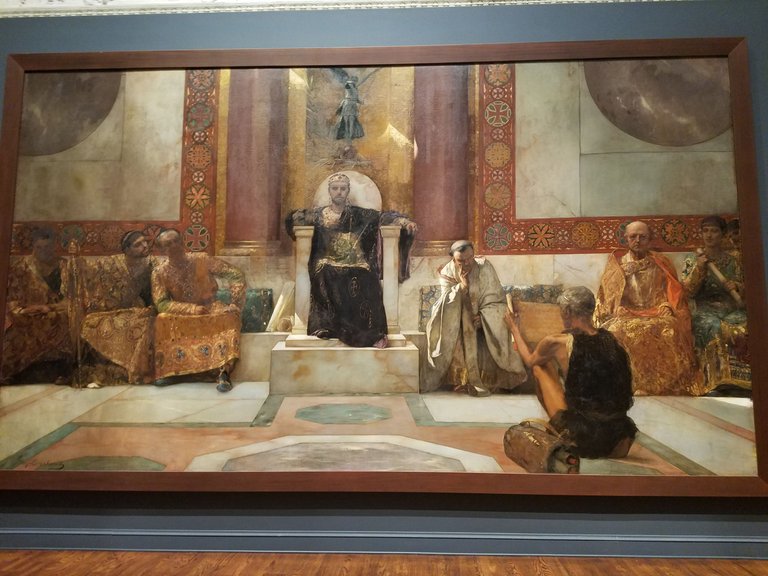
Portrait of a Woman, ca. 1515 - 1520
Oil on canvas
Workshop of Titian (Tiziano Vecellio)
Italian, c. 1485/90? - 1576)
Titian was the most important Venetian painter of the sixteenth century, and his work continued to influence European art long after his death. The woman in this painting is dressed in a style associated with the Ottoman Empire (centered in what is today Turkey, but which encompassed a vast area, including the Middle East). Titian and his workshop produced a number of paintings of women in "exotic" (Near Eastern or Turkish) dress, to satisfy local demand. Although in the past this painting has been thought to represent a specific person, it is more likely an idealized representation. Such "bella donna" (beautiful woman) paintings were sometimes commissioned as wedding presents for a bride.
Bequest of John Ringling, 1936, SN58
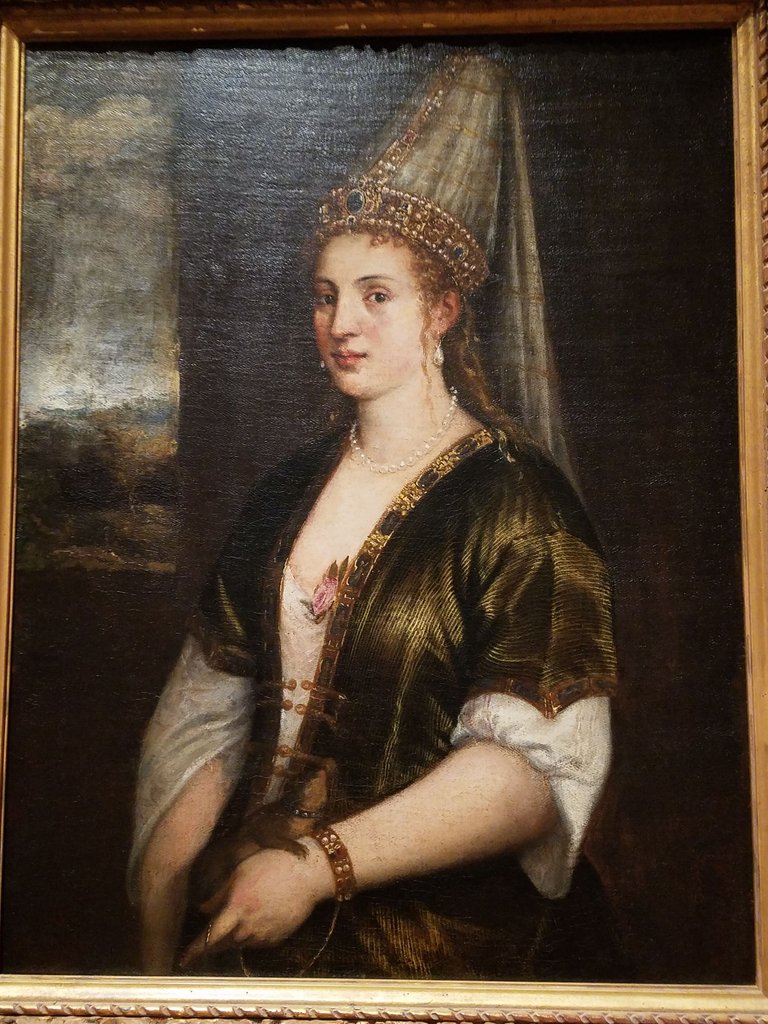
Moonlight Landscape, ca. 1785
Oil on canvas
Joseph Wright of Derby
British, 1734 - 1797
Wright was fascinated by light, both natural and artificial, and made it the subject of many of his paintings. This scene is based on careful observation; note especially the translucent clouds at upper left, the gradations of filtered color in the sky, and the light falling on the large tree at right. Yet it is also a skillful invention: we know the moon will only remain behind the bridge for a brief moment, and this heightens the painting's sense of quiet drama and wonder.
Museum purchase, 1972, SN906
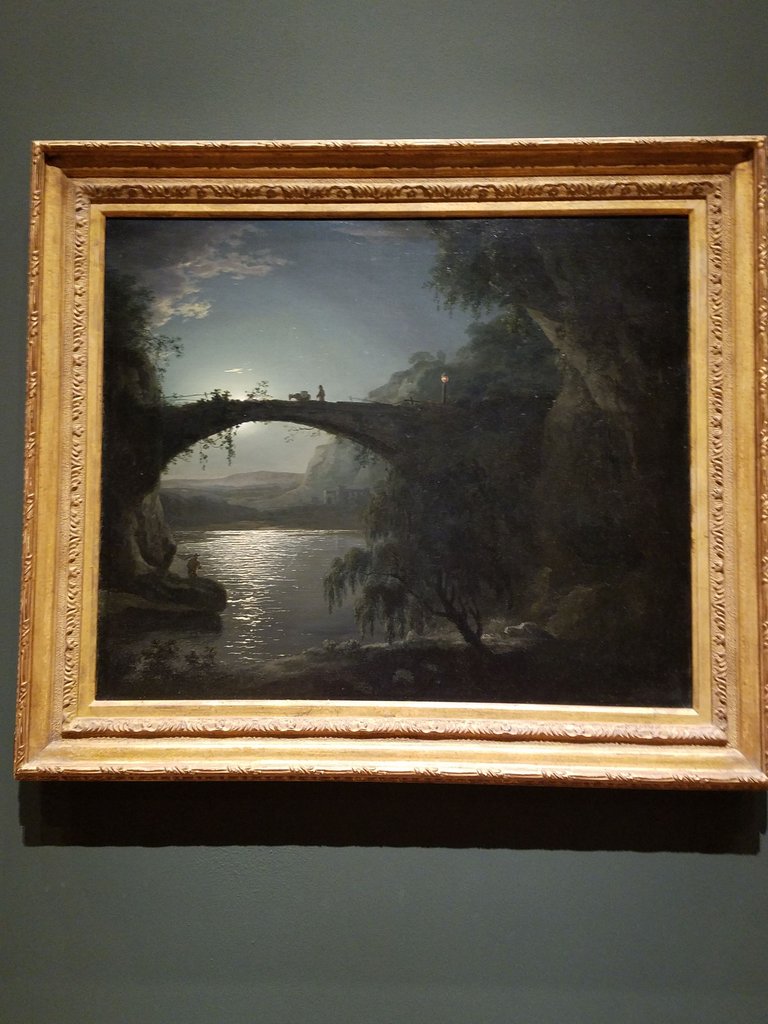
Portrait of a Lady, ca. 1760's - 1770's
Oil on canvas
Johann Georg Ziesenis
Danish, 1716 - 1776, active in the Netherlands and Germany
Ziesenis's portrait of a young woman captures the elaborate French fashions popular throughout Europe in this period. The floral silk of the dress and the more abstract flower and foliage patterns in the lace echo motifs found throughout the pieces decorative arts in this gallery, including the nearby cabinet and silver set. Although the Rococo style began in furniture, it could be found throughout the decorative arts, as in the textiles pictured here.
Bequest of John Ringling, 1936, SN327
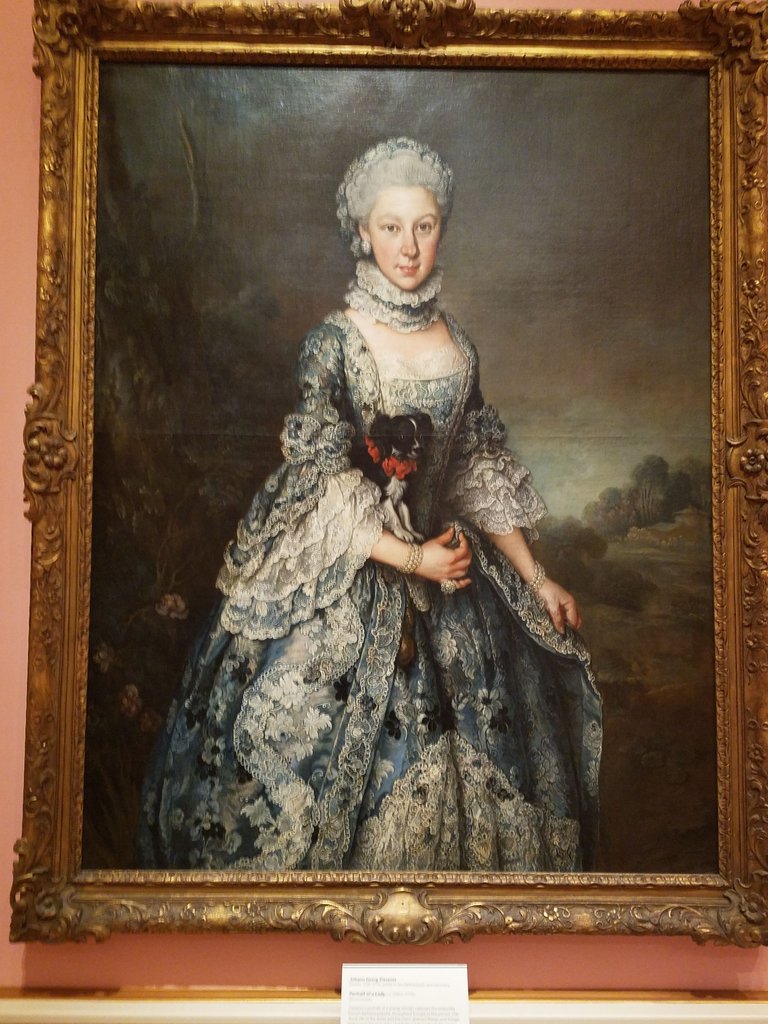
Two Allegorical Figures, 1760
Fresco transferred to canvas
Giovanni Battista Tiepolo
Italian, 1696 - 1770
Dimensions: 148 x 75 in. (375.9 x 190.5 cm)
Giovanni Battista Tiepolo was the most distinguished artist in 18th-century Europe, and his grand, decorative style epitomizes the Venetian aesthetic of the priod. This impressive painting was once a wall fresco decorating a palazzo in Vicenza. Painted to appear as bronze sculptures placed against a gray marble backdrop, the human figures, lion, cornucopia, and obelisk create a grouping that symbolizes triumph, glory, and eternity. In its original setting, this work would have been located high on a wall, probably above a doorway or fireplace.
Museum purchase, 1951, SN652
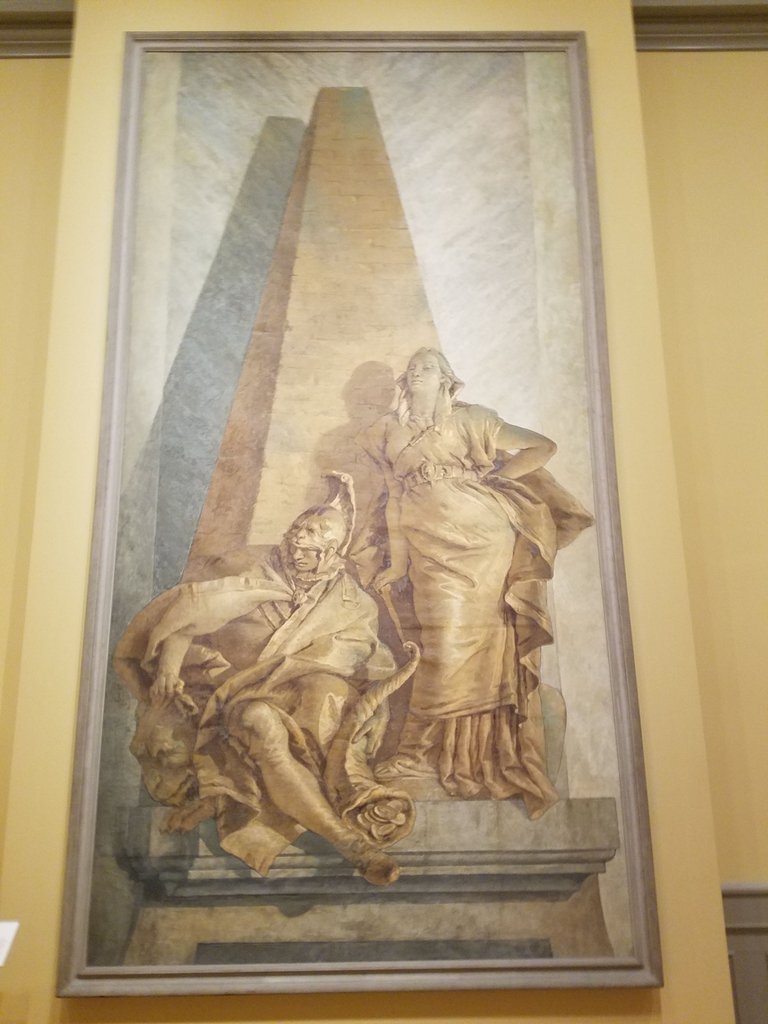
A Family Group Adoring the Veil of Veronica, c. 1490
Oil on panel
Artist: Unknown (Austrian)
This panel painting depicts a family, flanked by their patron saints, Peter and Jacob, in a church interior, venerating the Veil of Veronica, a cloth considered to show the first true likeness of Christ. In the background an altarpiece with the Passion cycle is visible, and the veil covers what is most likely a scene representing the Raising of the Cross. The painting may have been commissioned to commemorate the death of the matriarch of the family, of which the white cross in her hand is an indication.
Bequest of John Ringling, 1936, SN304
Bust of a Widow, late 16th – early 17th century
Painted terracotta
This woman may have been a nun, as suggested by her stern expression and somber clothing, or a widow, as her prominent widow's peak indicates. Terracotta models were commonly used in the 17th century as inexpensive, preliminary sketches for costly bronze or marble sculptures. Models made from terracotta instead of wood were seen as more artistic and were often used for presenting ideas to patrons, demonstrating how the final sculpture would translate in more expensive materials, giving form to ideas, and as a means of communication between master and assistant.
Bequest of John Ringling, 1936, SN5389
Christ Before Caiaphas, 1494
Cradled pine panel
Franconian Painter of the Nuremberg School
German, active during the late 15th century in Nuremberg
Bequest of John Ringling, 1936, SN305
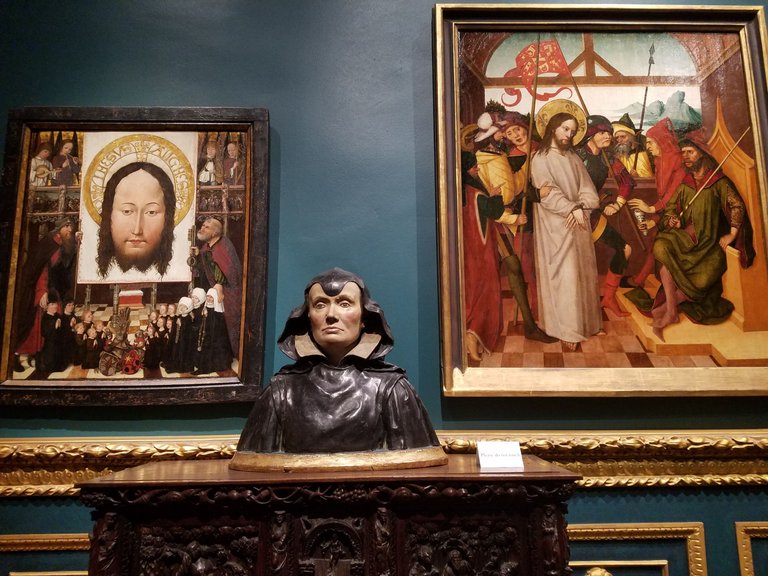
Female bust (Saint?)
Wood
Artist: Unknown
Bequest of John Ringling, 1936, SN5384
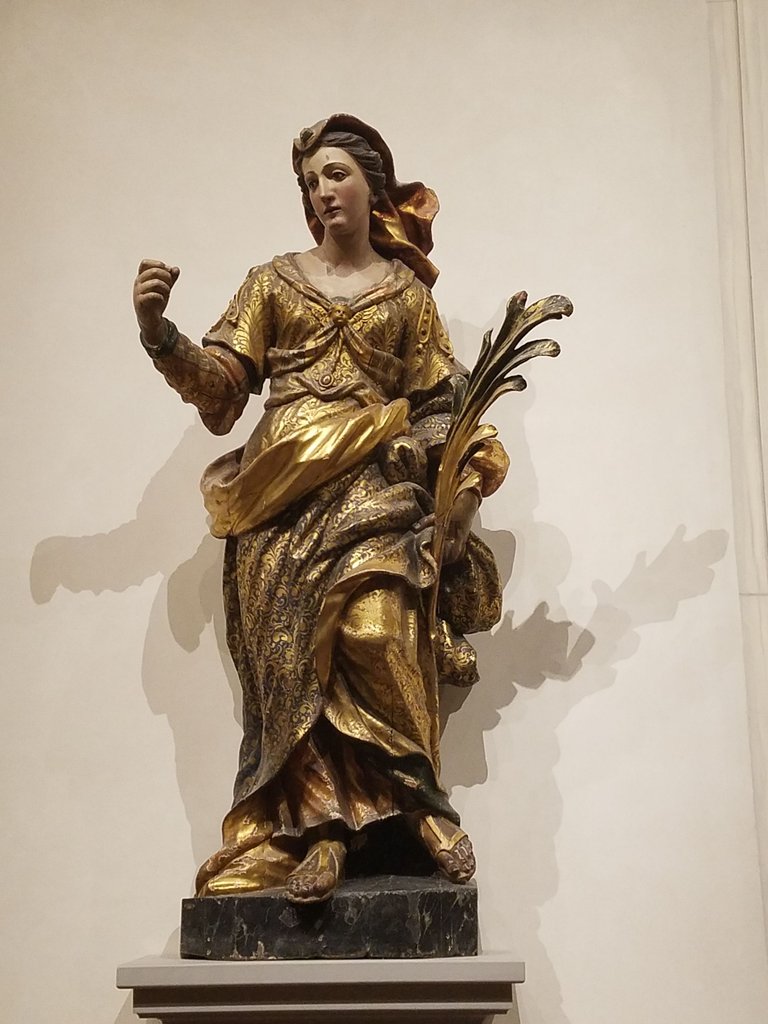
Interior with Monkeys, ca. 1717 - 1720
Oil on canvas
Gaspare Diziani
Italian, 1689 - 1767
Though painted by an Italian artist, this subject was inspired by Northern European paintings and prints of the 16th and 17th centuries - for example, the work of the Flemish painter David Teniers the Younger - in which monkeys are shown engaging in human activities. Such works provided satirical commentary on human nature. Diziani, who enjoyed a long career as a painter and stage designer, likely painted this while working in Germany.
Bequest of John Ringling, 1936, SN182
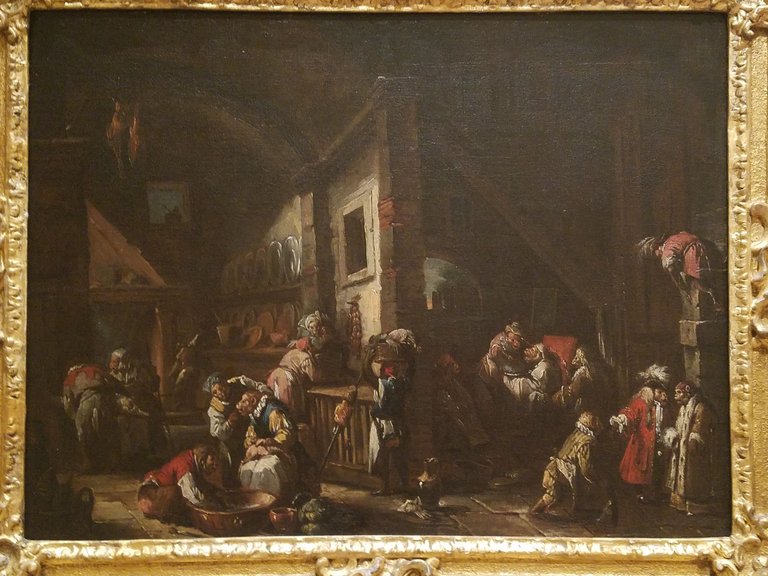
Elephant Attacked by Two Tigers, ca. 1890
Bronze
Makino Koshu
Japanese, active ca. 1890 - 1910
Bronze figures like this one were created in Japan in the late 19th century by artisans who had formerly produced weapons and armor for samurai, the Japanese military aristocracy. Social reforms introduced as part of the Meiji Restoration (1868) progressively abolished the samurai class, forcing metalworkers to adapt their skills for a new international market. With the support of the new government they began exporting their work and exhibiting at world fairs.
Bequest of John Ringling, 1936, SN7175
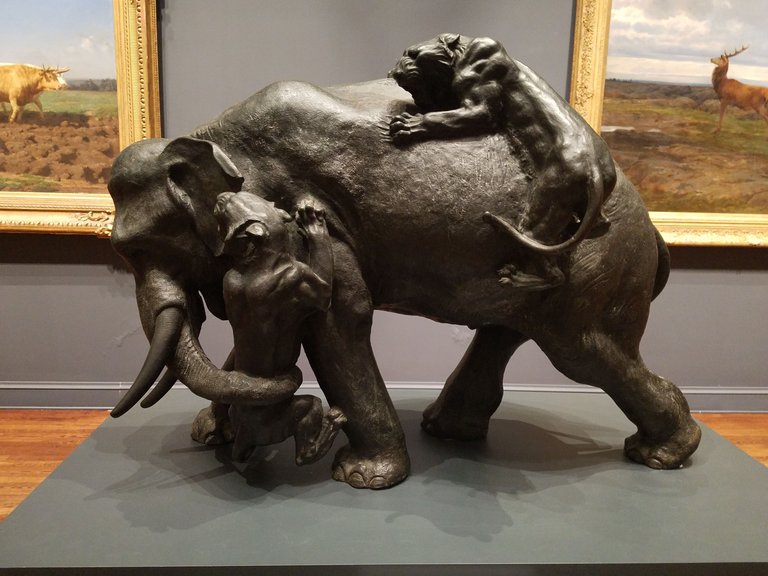
Roman Emperor
Early 20th-century bronze variant of ancient statue
Maker: Unknown
This statue in bronze is a copy, with significant alterations, of an ancient Roman marble that once decorated the courtyard of the Palazzo Grimani in Venice – the so-called "Grimani Augustus". The figure, a Roman emperor in full military attire, wears a decorated cuirass, mantel clasped at the shoulder, and a sheathed sword hanging by a shoulder strap. In his right hand he holds an orb and in his raised left hand a scepter, assuming a pose associated with the "adlocutio", an address delivered to the troops.
Bequest of John Ringling, 1936, SN5138
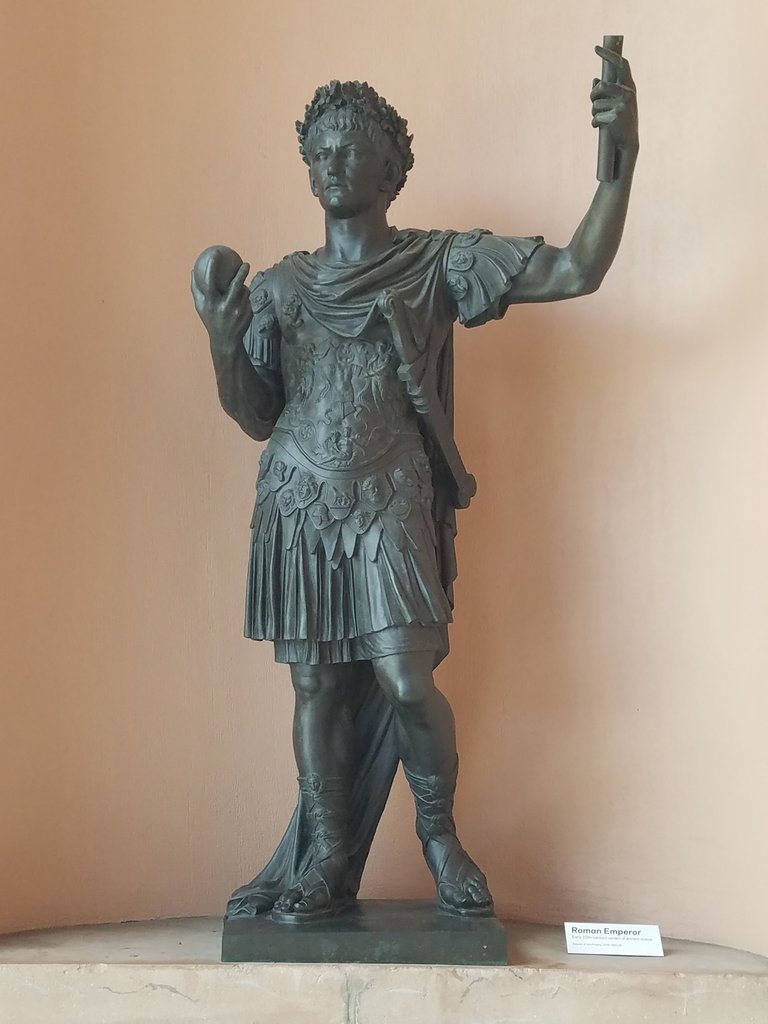
Hera Ludovisi
Early 20th-century bronze copy of ancient statue
Maker: Fonderia Chiurazzi (Italian, founded 1870)
For centuries in the collection of the distinguished Ludovisi family of Renaissance Rome, this colossal marble head was long believed to show the goddess Hera (Juno to the Romans) and was admired for its ideal beauty, particularly by German travelers of the 18th century. Since the late 19th century however, scholars have argued that the statue head is more likely a Roman portrait, perhaps of Antonia Minor (36 BC - 37 AD; mother of Emperor Claudius), represented as a goddess.
Bequest of John Ringling, 1936, SN5071
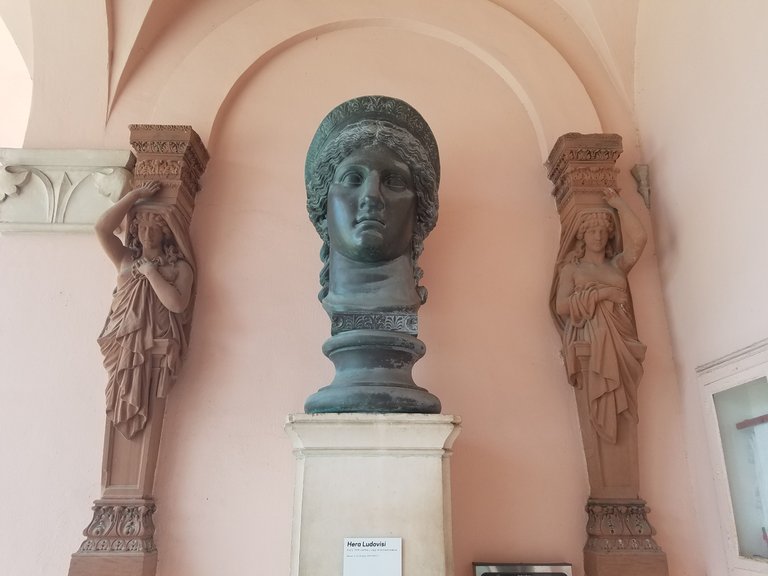
One of my favorite parts of the Art Museum was the sculpture garden in the courtyard.
The Museum Courtyard, the Ca' d'Zan Terrace, and other parts of the Ringling can be rented for weddings, receptions, and special events:
https://www.ringling.org/about-ringling/venue-rentals/
Here are some views from the upper balcony:
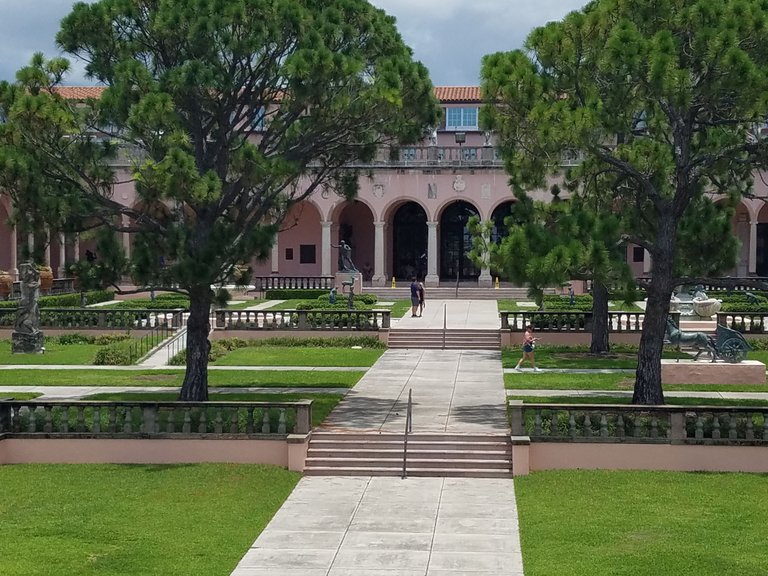
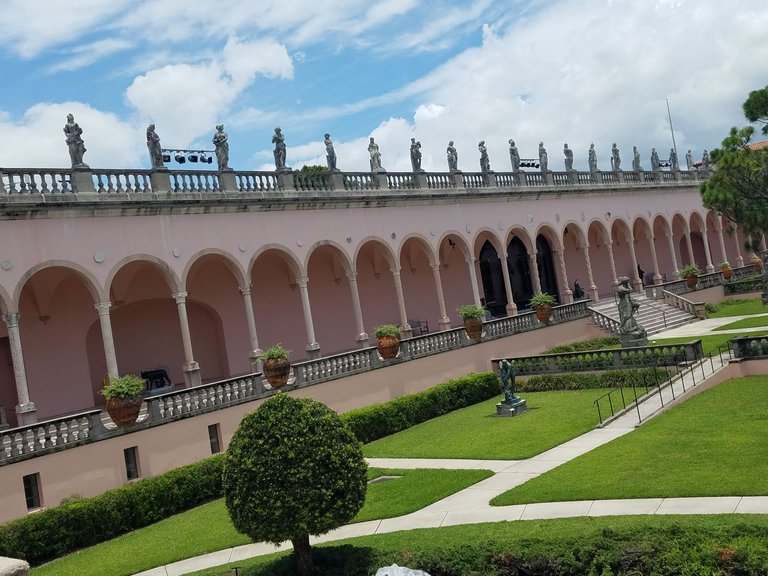
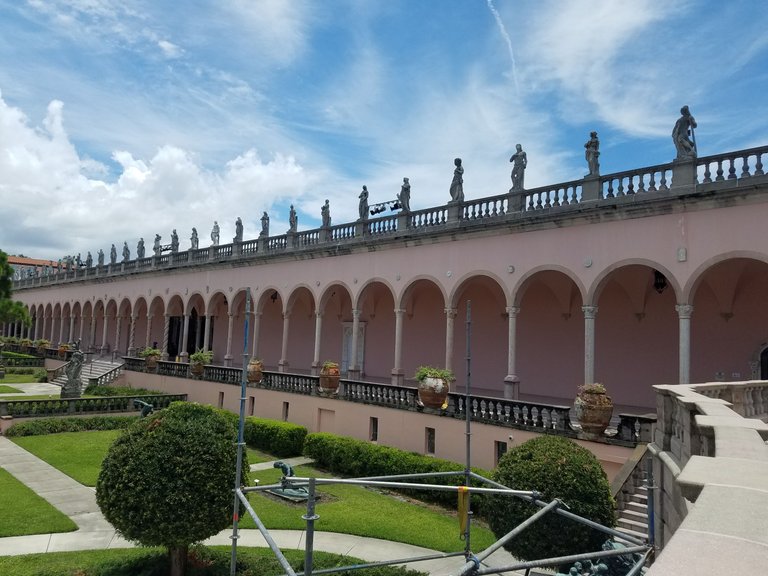
And here are some views from the ground level:
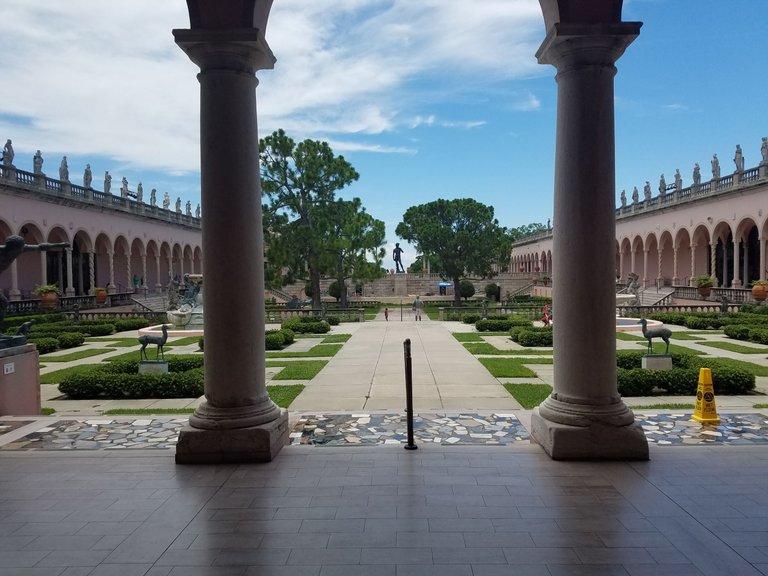

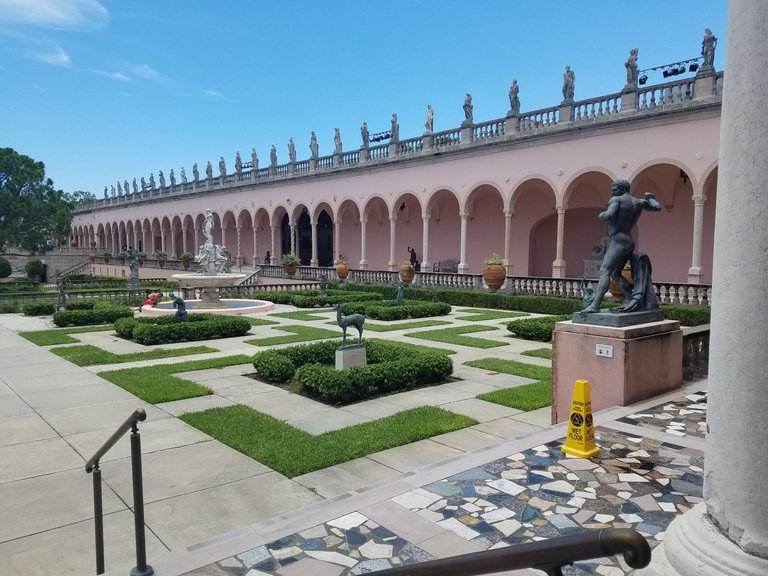
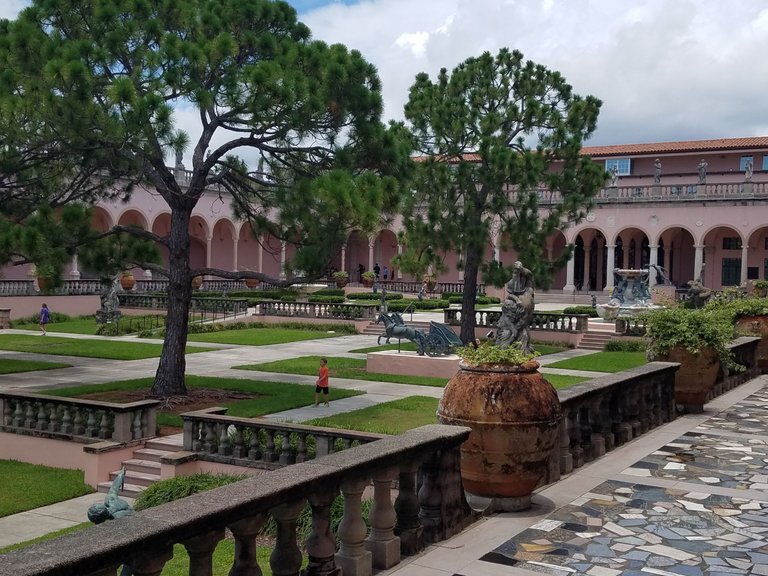
The bronze statue of David is featured prominently in the courtyard.
David, early 20th century
Bronze
Artist: Michelangelo Buonarroti
Italian, 1475 - 1564
Maker: Fonderia Chiurazzi
Italian, founded 1870
Dimensions: 198 3/4 in. (504.8 cm)
Fully nude and standing over seventeen feet tall, Michelangelo’s "David" was a revelation in Renaissance sculpture and remains today the most recognizable statue in the world. The figure’s dimensions, piercing gaze, and tensed musculature were a subject of discussion in the 16th century just as they are now, drawing admirers and detractors alike, all of whom played a part in determining the artistic and psychological significance of such a masterwork. In Florence, the statue became an image of republican fortitude, and in Sarasota, centuries later, it has become a symbol of the city’s identity as an arts capital. Assuming a familiar "contrapposto" stance and poised with his humble armaments – a stone and a sling – "David" was as much a summation of antique and Renaissance sculpture as it was a break with tradition. The pose and treatment of the body are decidedly ancient, filtered through Renaissance sensibilities. But not since the Romans had anyone erected a nude male figure of such colossal proportions, nor with as much attention to human anatomy and interest in accentuated bodily forms. The choice of subject, the biblical David, was not novel either. Sculptors Donatello (ca. 1386 - 1466) and Verrocchio (ca. 1435 - 1488) had in the previous century shown the young hero standing victoriously over Goliath’s severed head. Michelangelo however cast David not as a haughty, ephebic prince but as a powerful, muscled young man, choosing to show him in the moments just before the battle. Its artistic qualities and symbolic potential were immediately recognized, and the statue, originally intended for the buttresses high up on the Florence Duomo, was placed instead at the entrance to the political center of the short-lived Florentine Republic (1494 - 1512), the Palazzo della Signoria. The statue stood there until the late 19th century, when it was removed to its present location in the Galleria dell’Accademia. By virtue of the prime real estate it occupied and its subsequent glorification by art history (Vasari said it “eclipsed all other statues”), the "David" was copied extensively. The Ringling "David", made in bronze from a cast of the marble original, has been the centerpiece of John Ringling’s Renaissance-inspired art museum since its founding in the late 1920s.
Bequest of John Ringling, 1936, SN5466
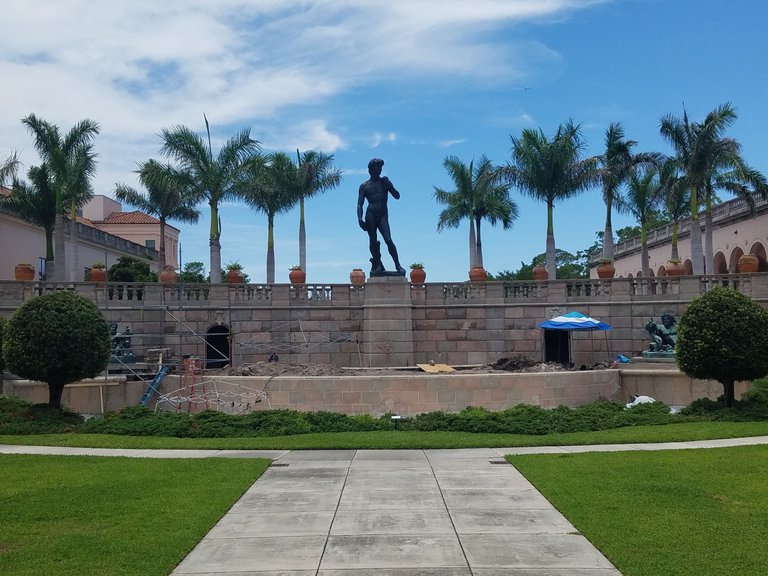
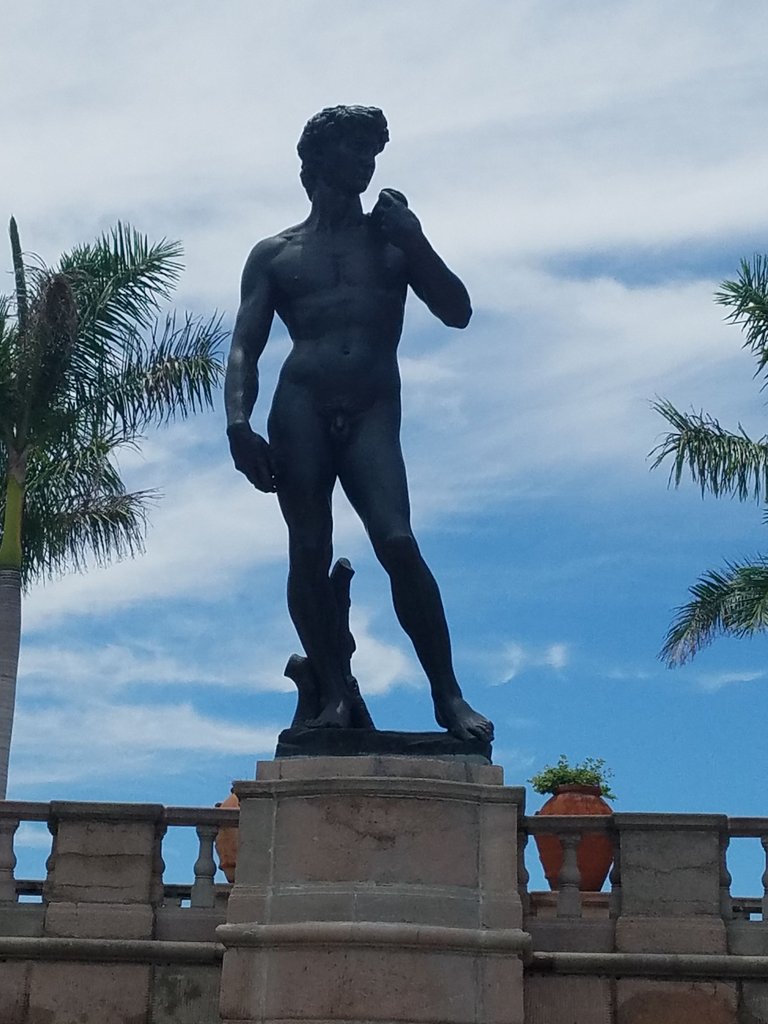
Joseph’s Coat: A Skyspace, 2011
Concrete, plaster, marble, granite, LED lights, cypress, open space, jasmine, paint, steel
James Turrell
Dimensions: 588 × 840 × 840 in. (1493.5 × 2133.6 × 2133.6 cm)
Joseph’s Coat Skyspace is a triumph of technology, engineering, and aesthetics. The Skyspace, created by internationally-renowned artist James Turrell, is a gathering place for contemplation, and sustained experience. At sunset, a sophisticated system of LED lights is employed to change the color of the space. In doing so, the artist changes the context in which you view the sky and can radically change your perception of the color of the sky and its spatial relation to you. As you gaze up at the sky through the 24 foot square aperture in the ceiling, you are invited to contemplate light, perception, and experience. Joseph's Coat is a unique experience.
SN11201

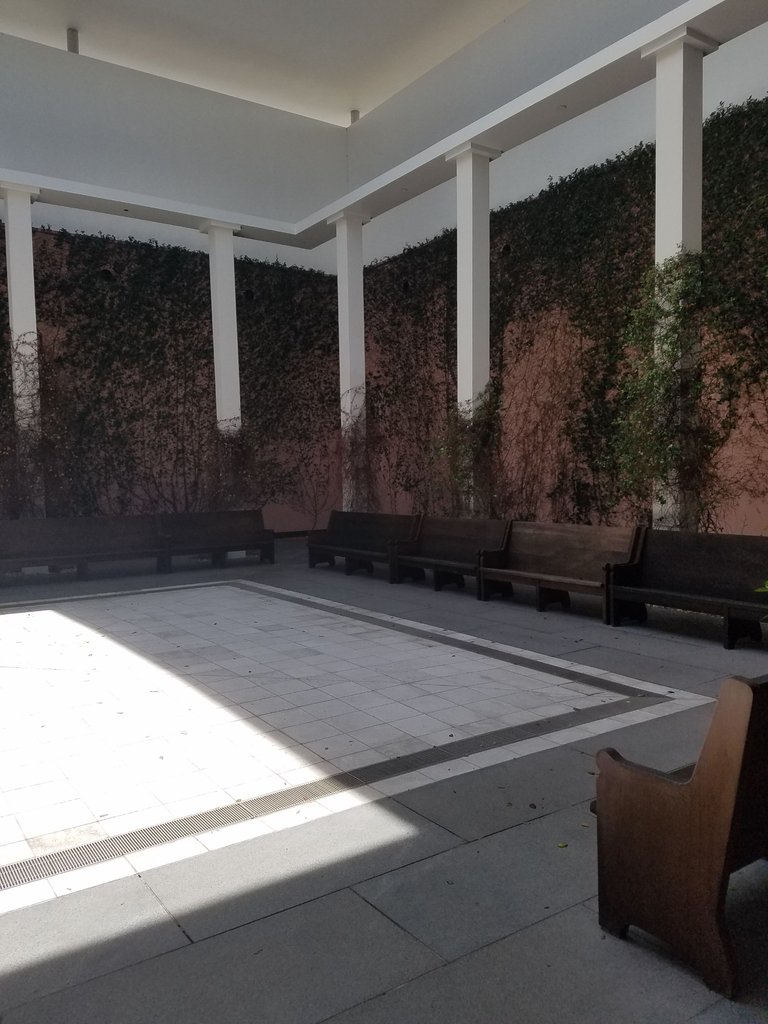
Fireplace from the Salon of the Huntington Mansion, 1892 – 1895
Marble
The fireplace and door surround permanently installed in this gallery come from the Salon (also called the East Room) of the Huntington mansion in New York City. Decorator and muralist Francis Lathrop saw to the design of both elements, commissioning plaster models of the figures from a company in Paris before handing over the marble work to the decorating firm Herter Brothers. When the French-style Salon was completed in 1895, the door surround supported two sconces, and the fireplace featured an ornate mirror in the central recess.
Bequest of John Ringling, 1936, SN11444
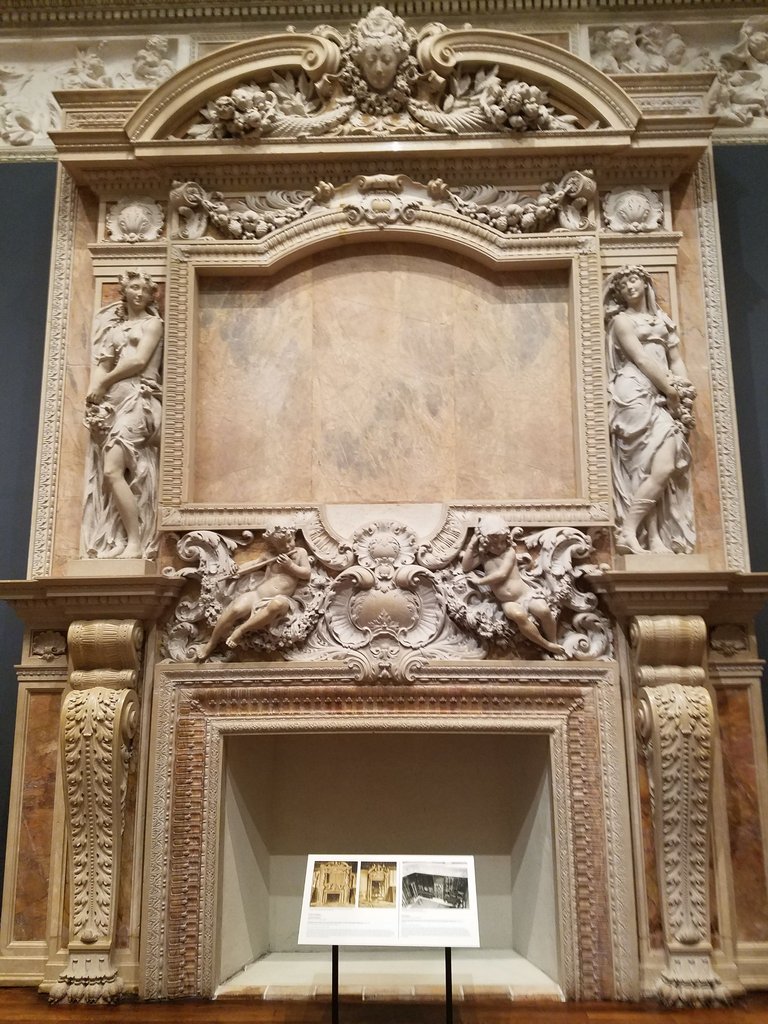
Astor Crème Salon
Wood, plaster, metal, gold leaf
Designer: Jules Allard and Sons
French, 1878 – 1907
Bequest of John Ringling, 1936, SN11273
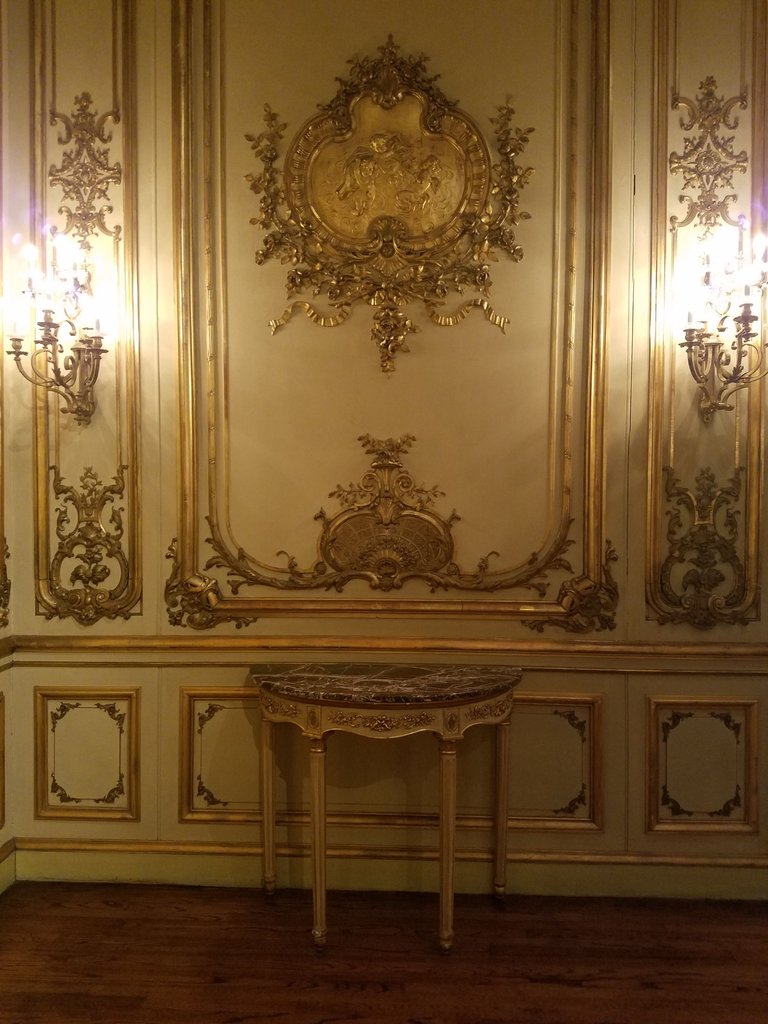
Astor Library
Wood, plaster, metal, gold leaf
Designer: Jules Allard and Sons
French, 1878 – 1907
Bequest of John Ringling, 1936, SN11274
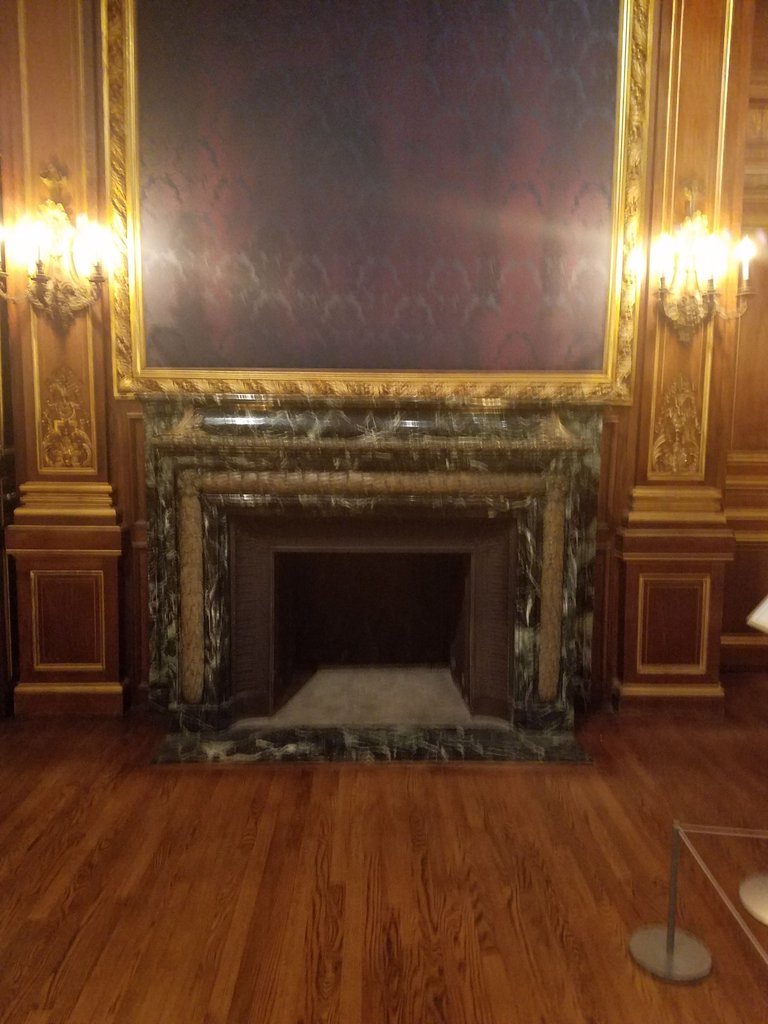
Harpsichord, 1652
Carved, painted and gilded wood
Claude Jacquet
French, active in Paris after 1632
This instrument is a rare surviving example of a 17th century French harpsichord. The open lid reveals a scene of the god Apollo pursuing the nymph Daphne. Daphne prayed for rescue and was turned into a laurel tree as Apollo touched her. When the harpsichord was made, Louis XIV was king of France. Louis used the sun as his emblem, and the sun is associated with Apollo, god of Peace and the Arts. Images and attributes of Apollo appear throughout works of art made for Louis and his court.
Bequest of John Ringling, 1936, SN1108
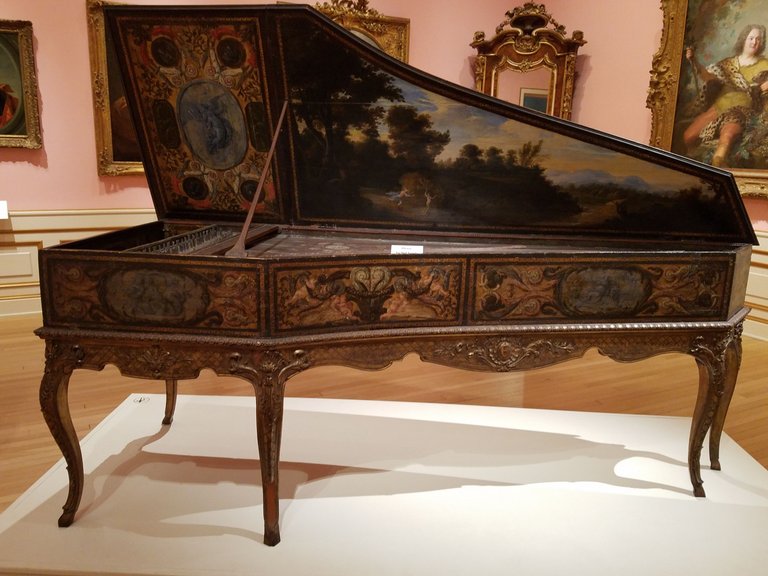
Ebony and Tortoiseshell Veneered Cabinet Inset with Painted Panels, 1600's
Paintings attributed to Frans Francken
Flemish, 1581 - 1642
The city of Antwerp in the southern Netherlands was a leading center for the manufacture of cabinets used to store jewelry, documents, and other small personal items. A specialty of Antwerp cabinet makers were pieces combining wood veneered to look like ebony and tortoiseshell with small oil paintings of scenes often drawn from ancient mythology or the Bible. The scenes here are from the Old Testament. At center is a depiction of Hagar and Ishmael in the wilderness, the subject of Dujardin’s painting nearby.
Museum purchase, 1974, SN1950
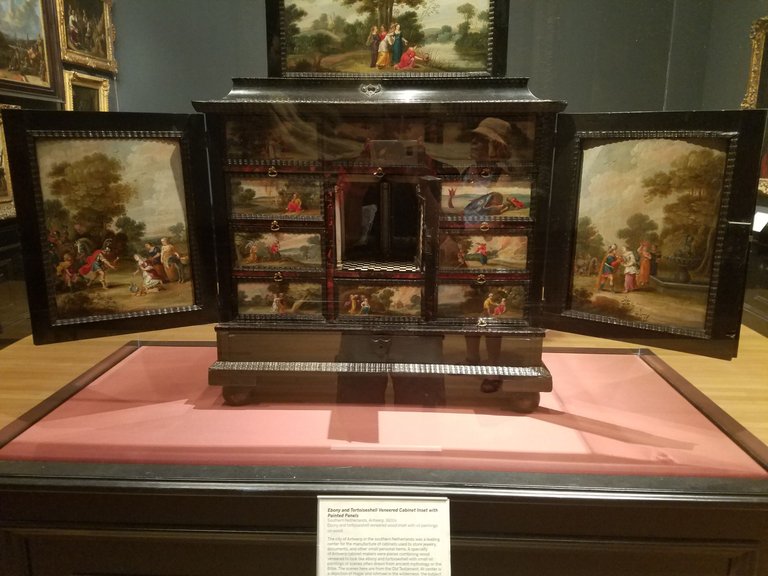
A collection of pendants, watches, and crosses:
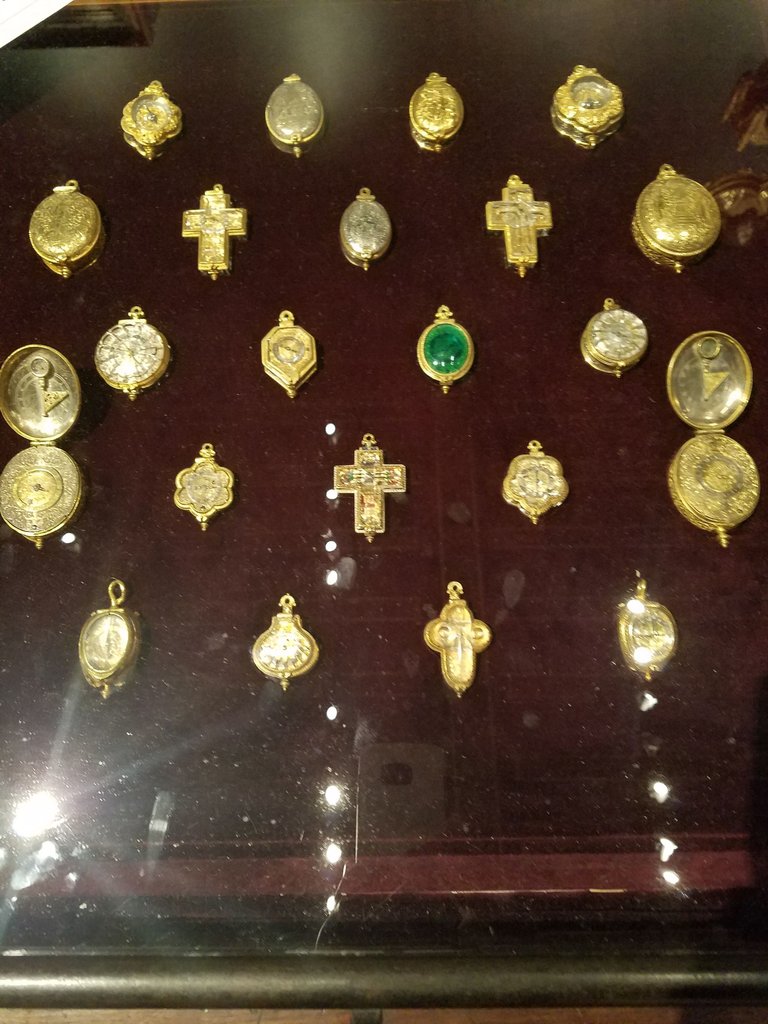
Hare Eating Grapes, second half of 18th century
Porcelain with turquoise glaze
The motif of hares eating grapes is unusual in Chinese art; it may relate to imagery found in Roman mosaics and sarcophagi. These twin hares were probably made with the European market in mind. Vivid peacock-blue glazes, similar to colors used in Middle Eastern ceramics, reached a peak after the Kangxi emperor (r. 1662–1722) restored the Ming dynasty (1368–1644) imperial kilns at Jingdezhen in 1680.
Gift of Ira and Nancy Koger, 2001, SN11122.253 & SN11122.254
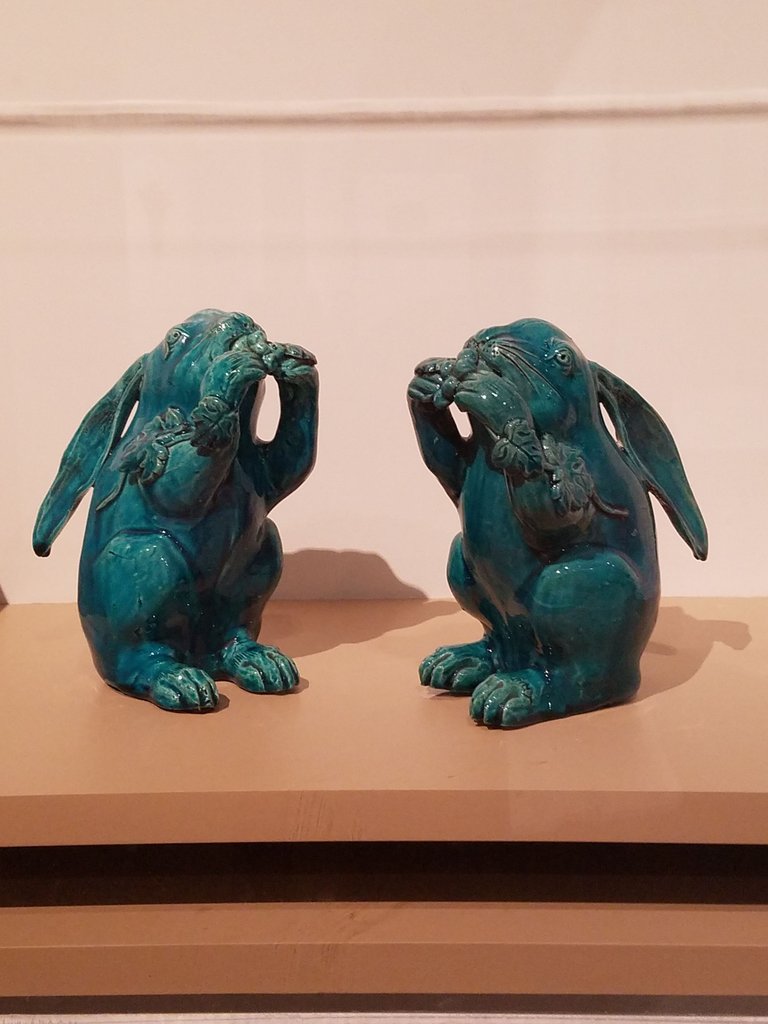
Icon of a Seated Shiva, 18th century
White marble
Gift of Eleanor B. Lehner, 1994, MF94.8.19
Seated Ganesha, 19th century
White marble
Gift of Eleanor B. Lehner, 1994, MF94.8.20
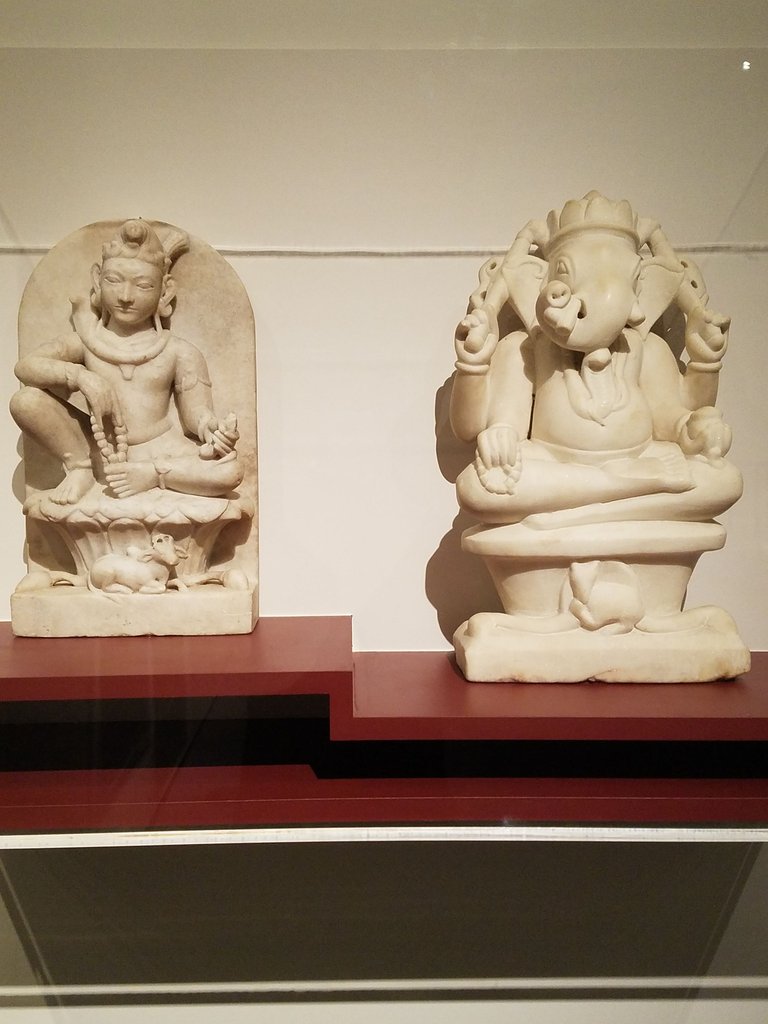
I could not find this sculpture in the Ringling's online collection database but on other websites this piece is often described as:
Guanyin, 10th century AD, Song dynasty (China)
Gray argillaceous sandstone with some polychrome
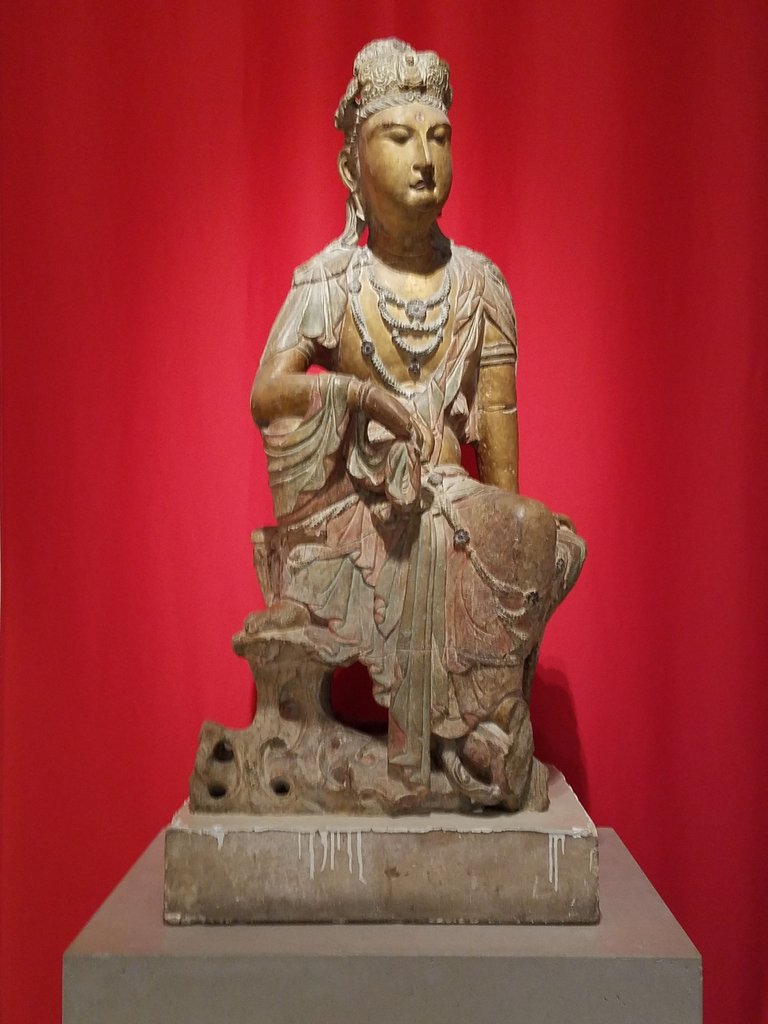
Here is another Buddhist statue:
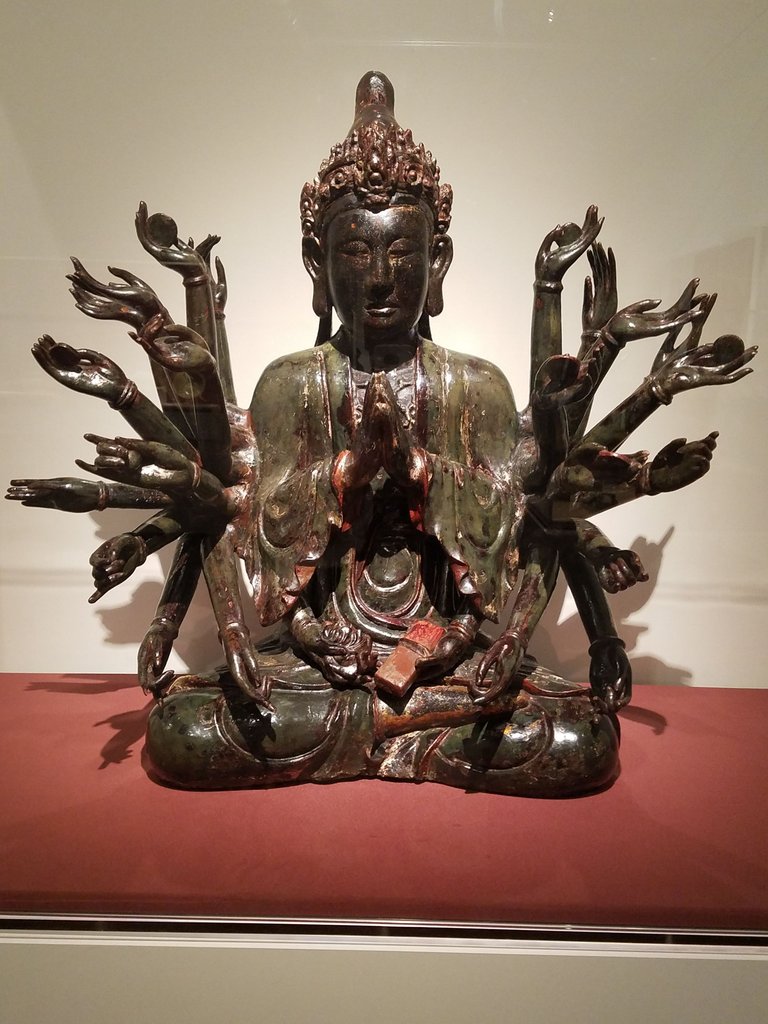
Shinique Smith: Parade Special Exhibit
https://www.ringling.org/event/shinique-smith-parade/
There was also a modern exhibit interspersed throughout the building. However, I found the modern style to clash with the classical and renaissance aesthetics. I would have preferred if the tightly bundled fabric sculptures were featured in a separate section with other contemporary art.
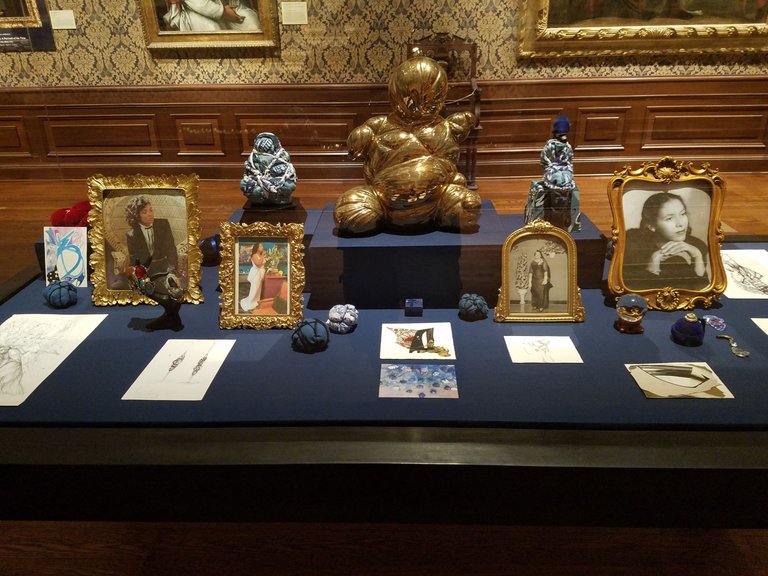
BAYFRONT GARDENS
A view of Sarasota Bay from the Art Museum:
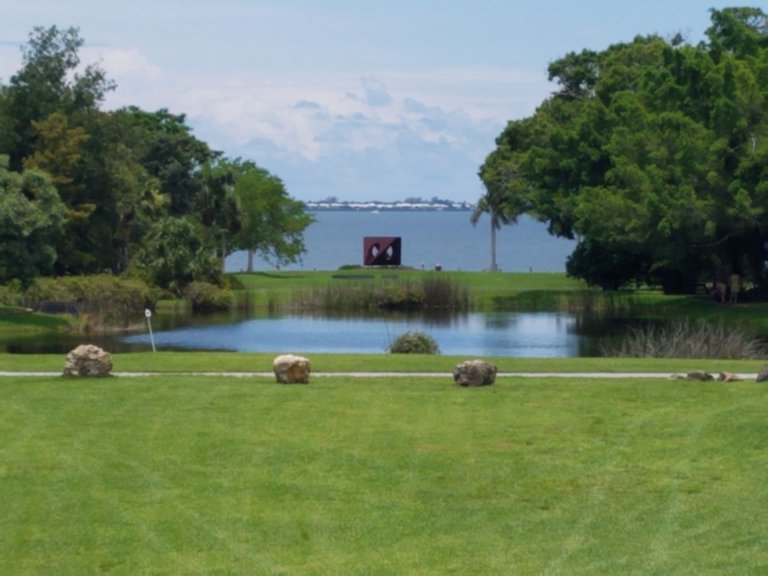
Royal Poinciana
Delonix regia
Madagascar
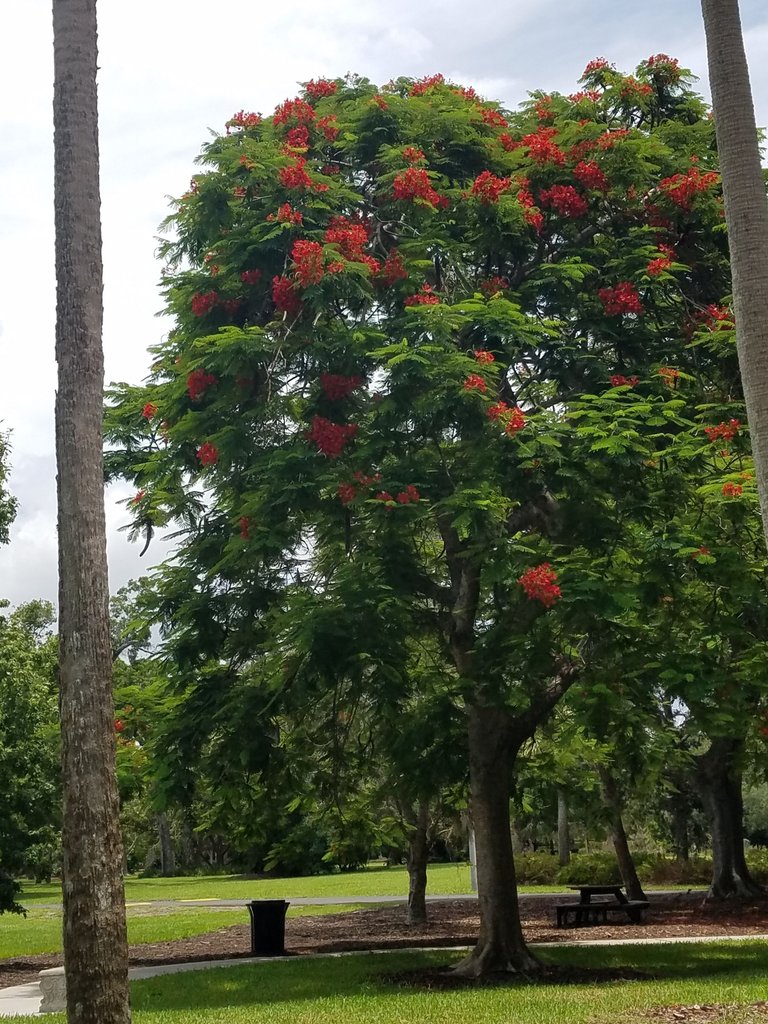
The Secret Garden:
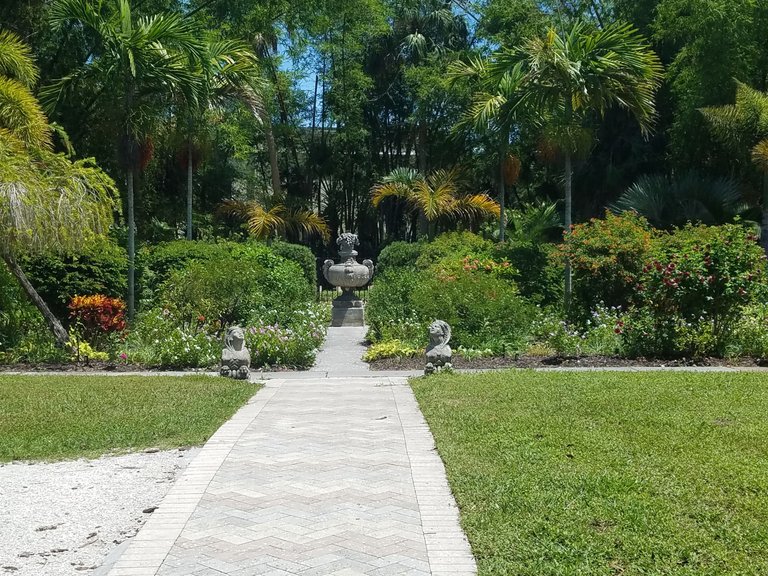
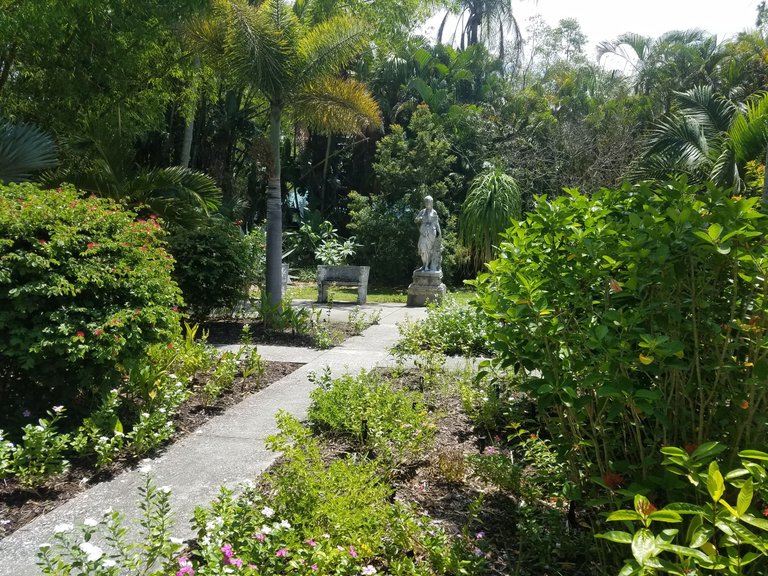
Burial site of the Ringlings:

Reflecting Pool:
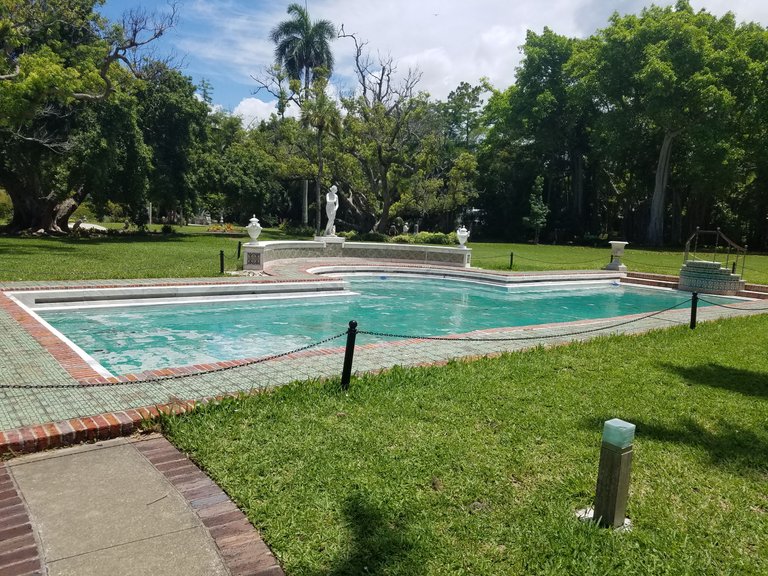
These are some exterior views of the Ca' d'Zan that you can view for free:
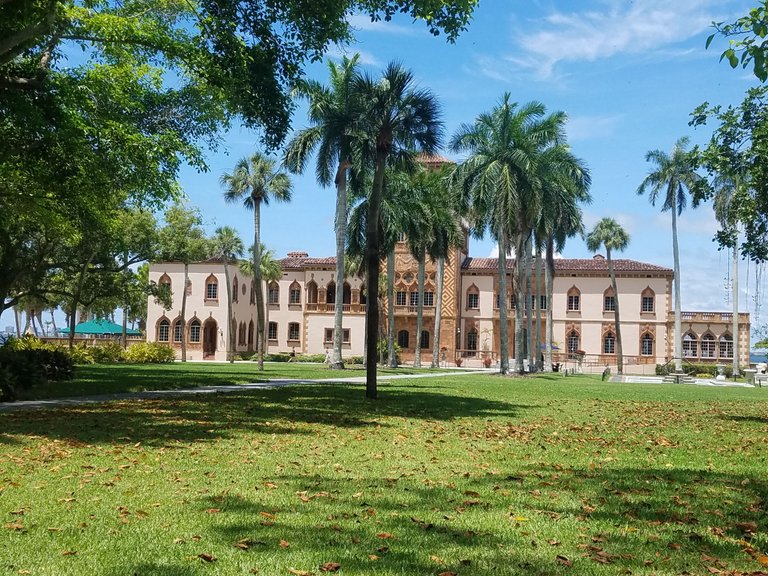
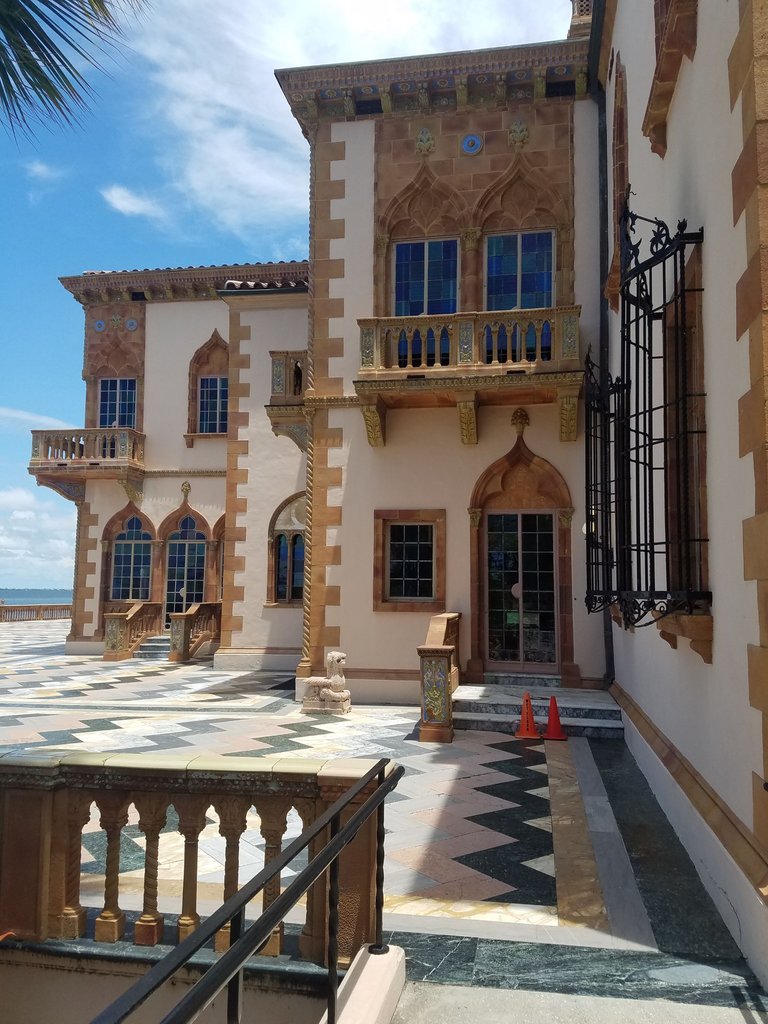

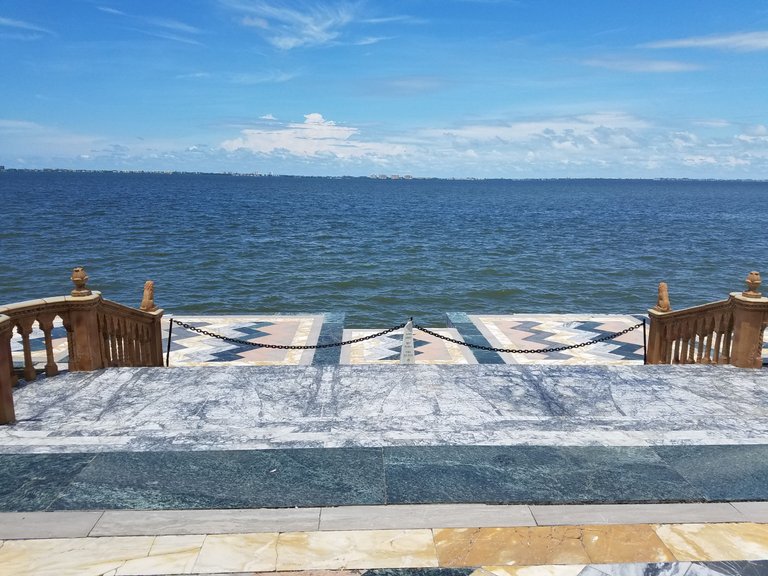
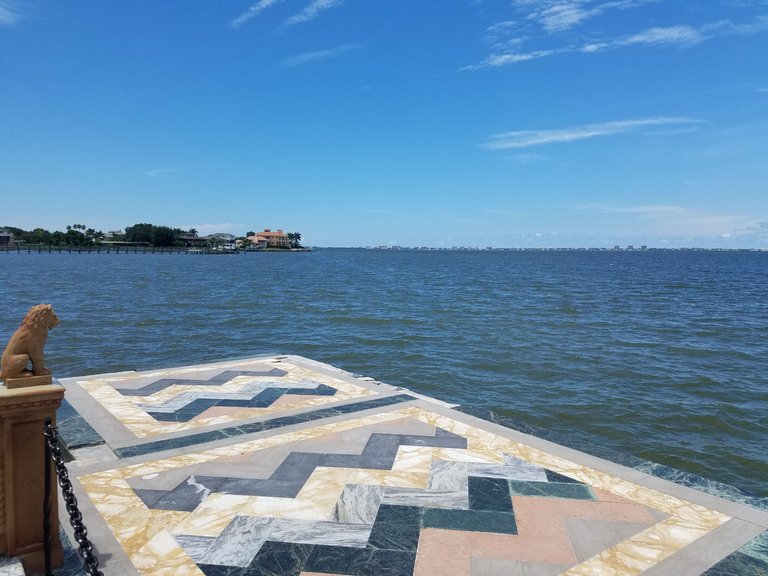
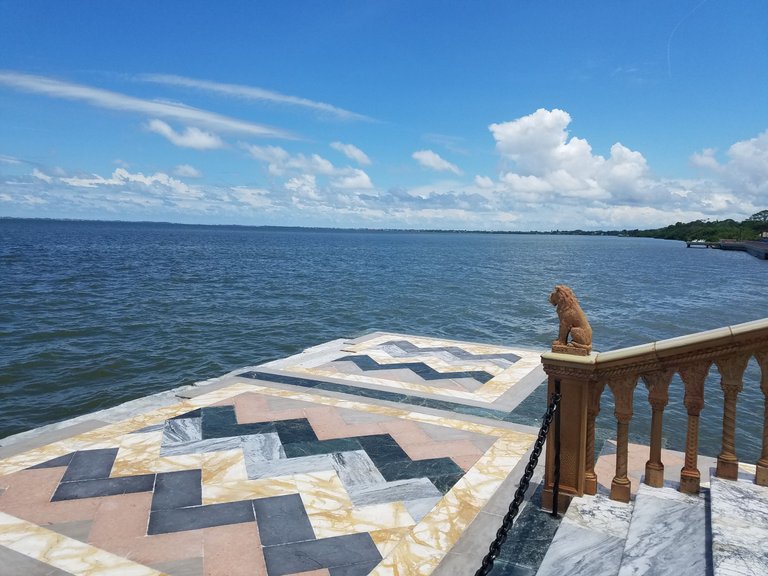
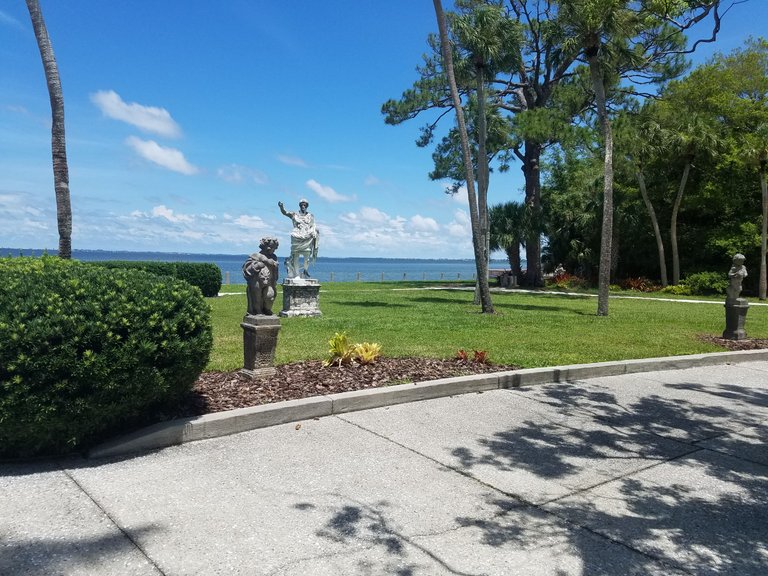
CA' D'ZAN
The audio tour for the first floor of the Ca' d'Zan can be found here:
https://www.ringling.org/visit/maps-guides/ca-dzan-audio-guide/
Room at the entrance:
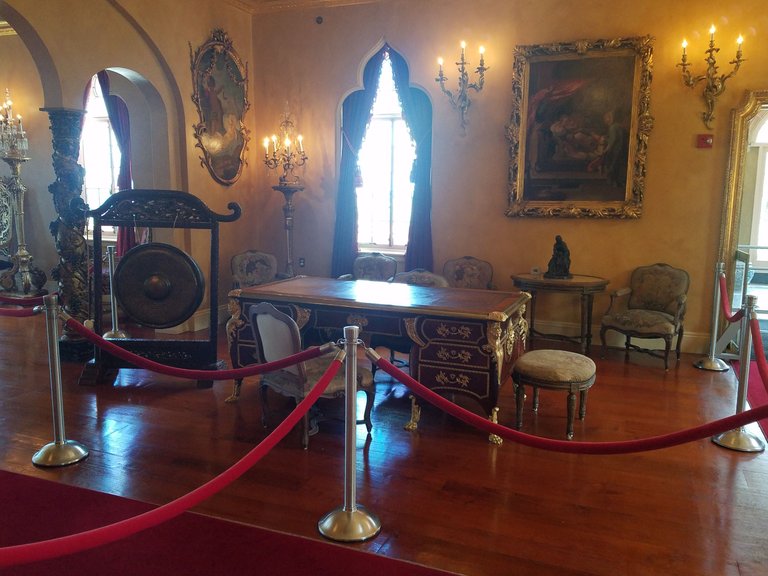
Dining Room:
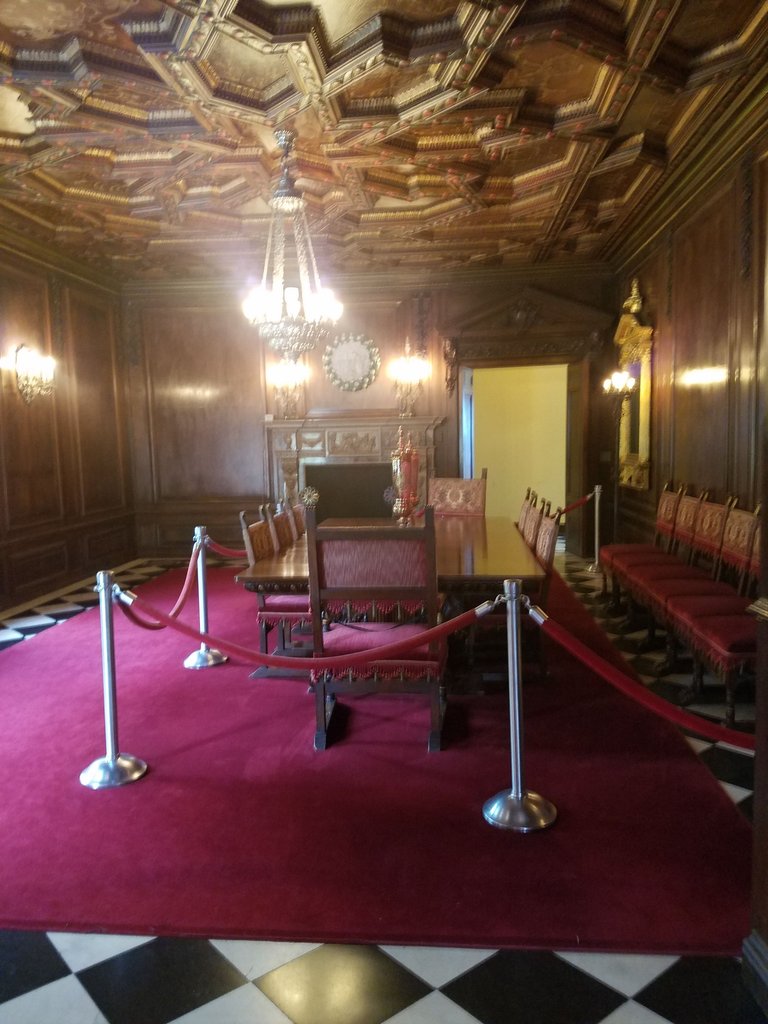
Ceiling of the Dining Room:
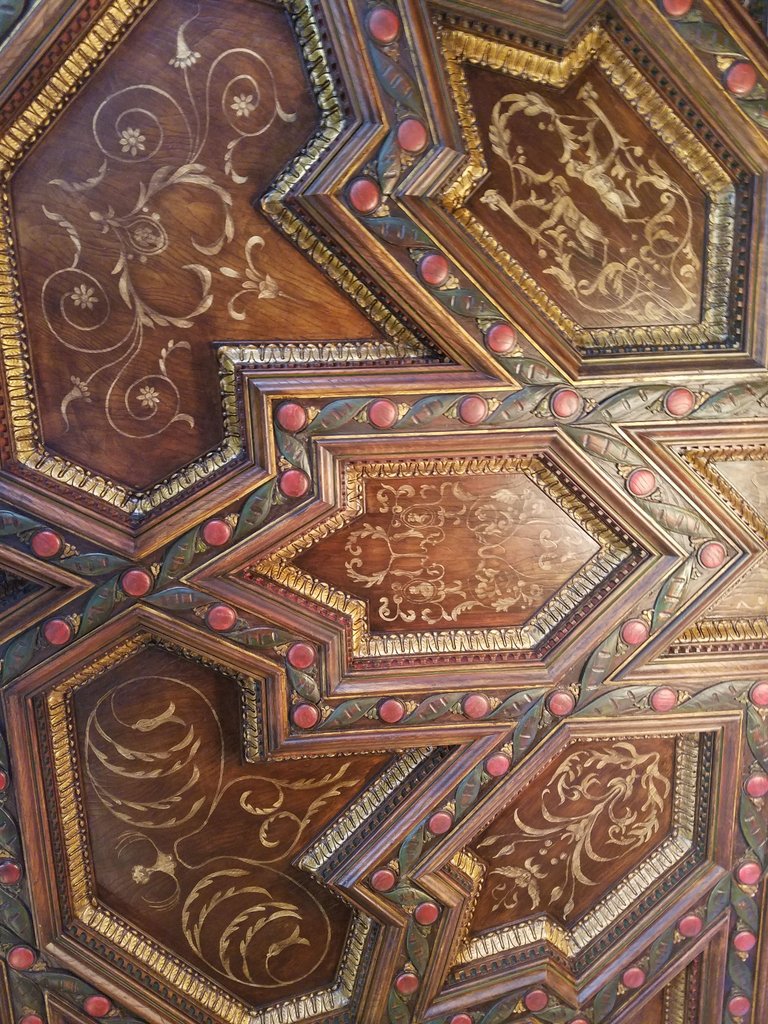
Tap Room:
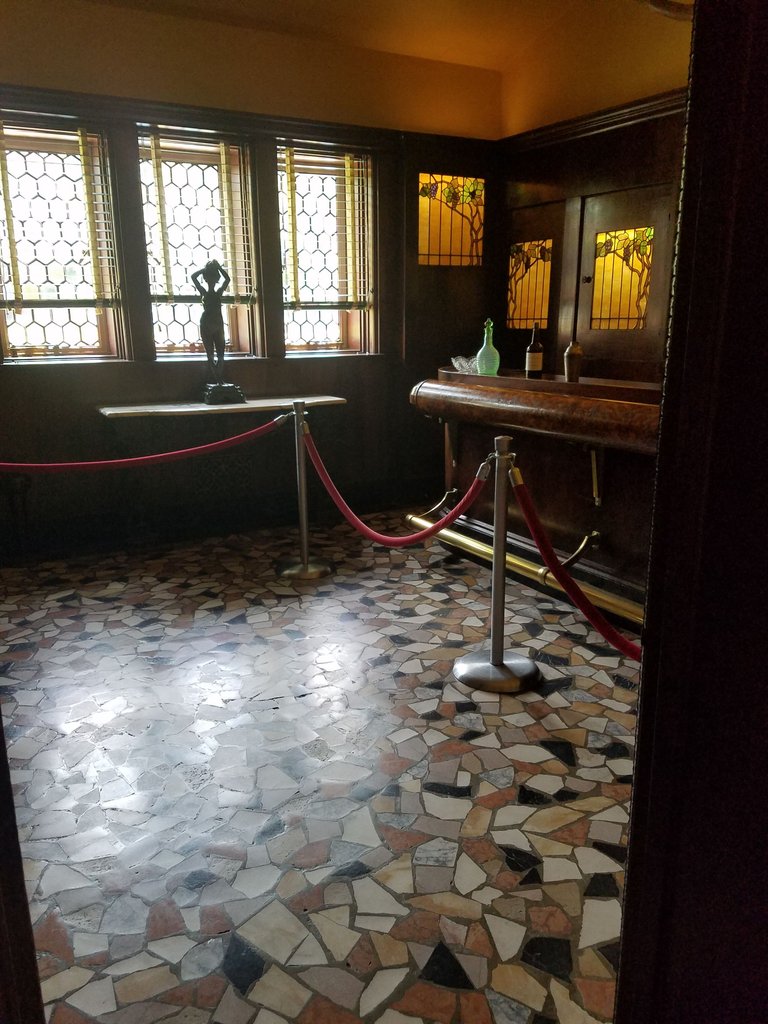
Ballroom:
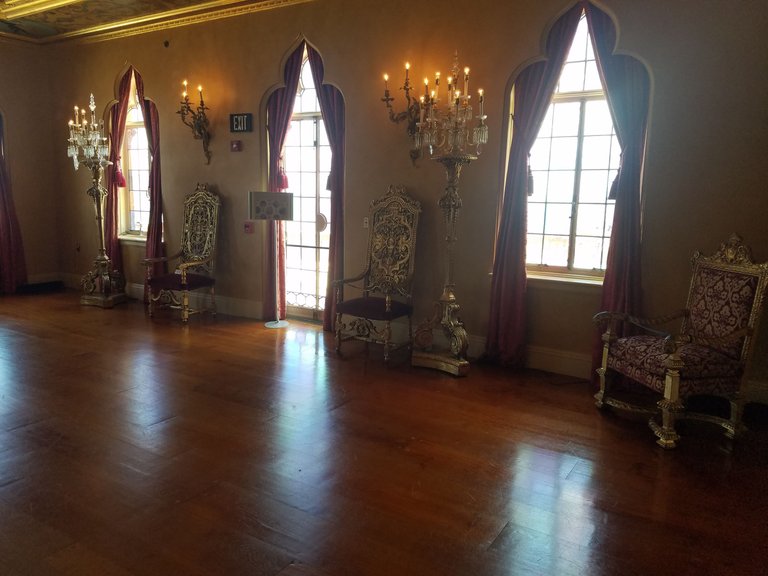
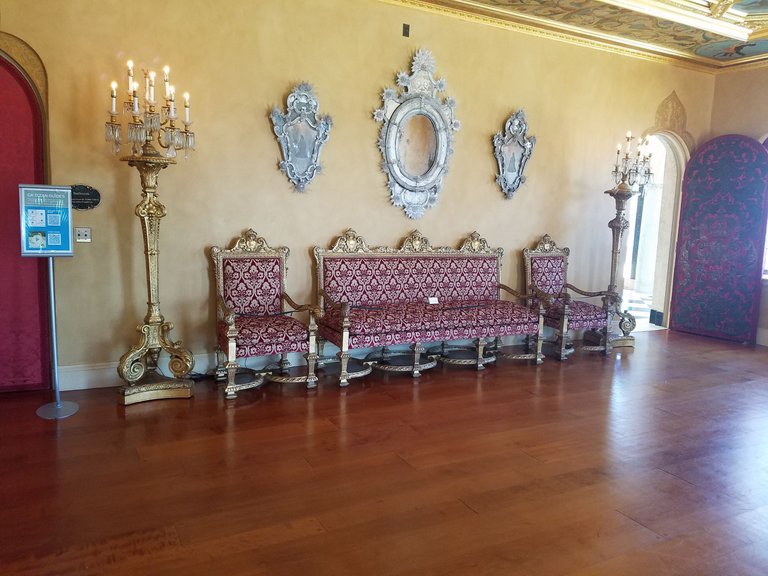
Ceiling of the Ballroom:
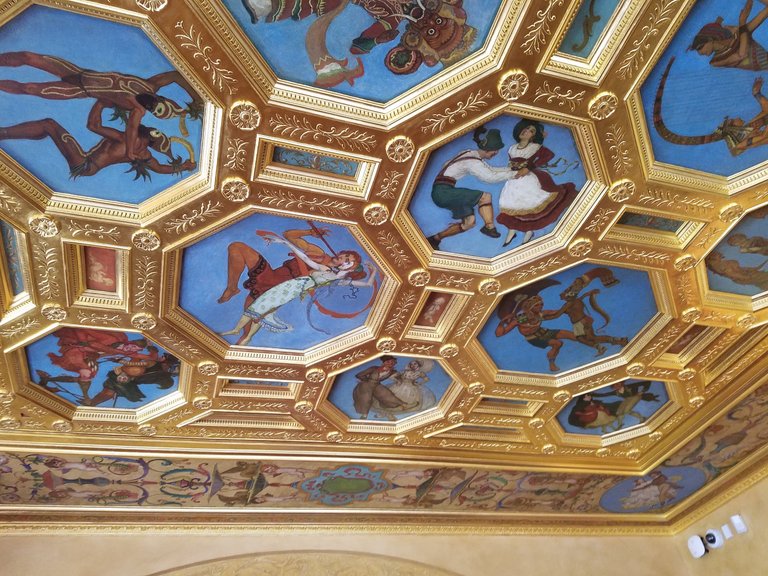
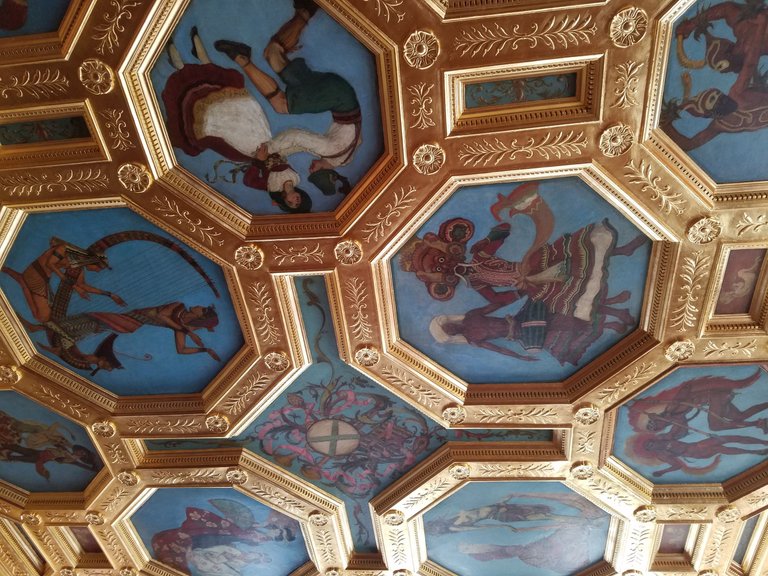

Great Hall:
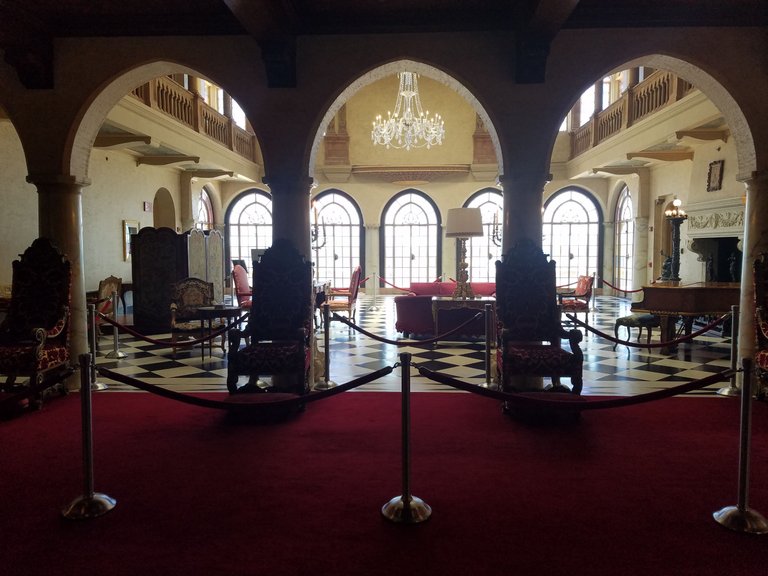
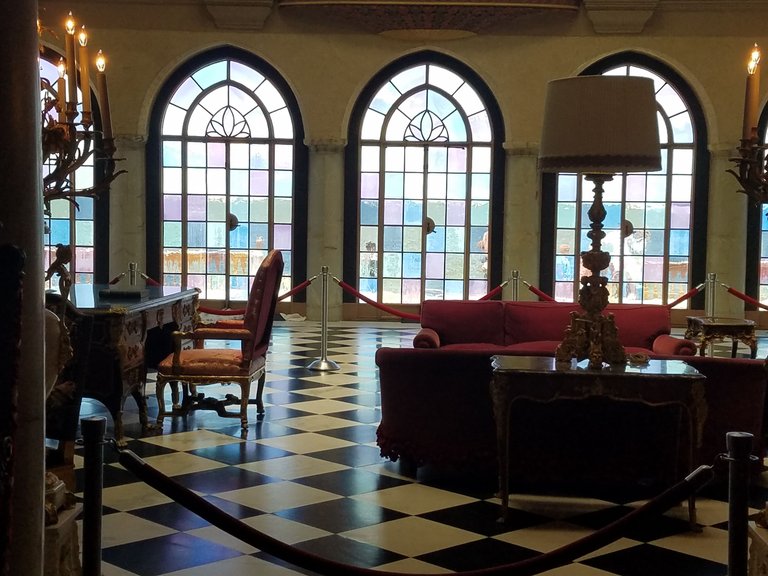
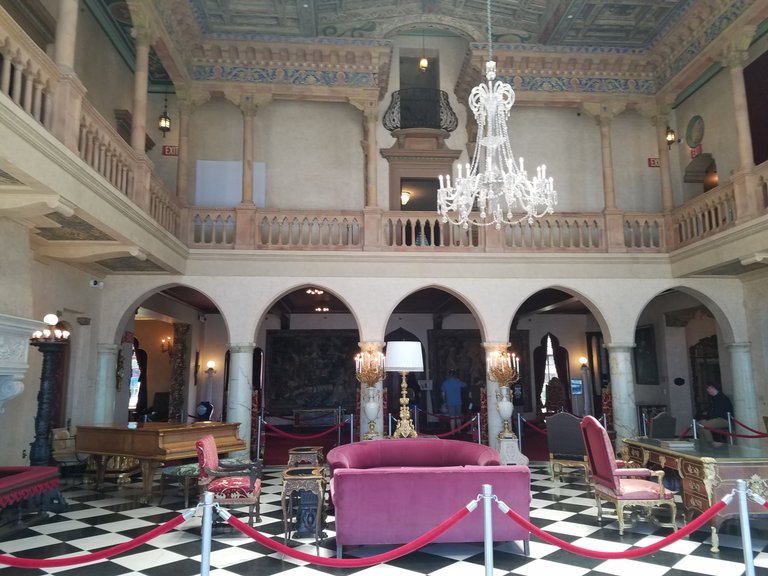
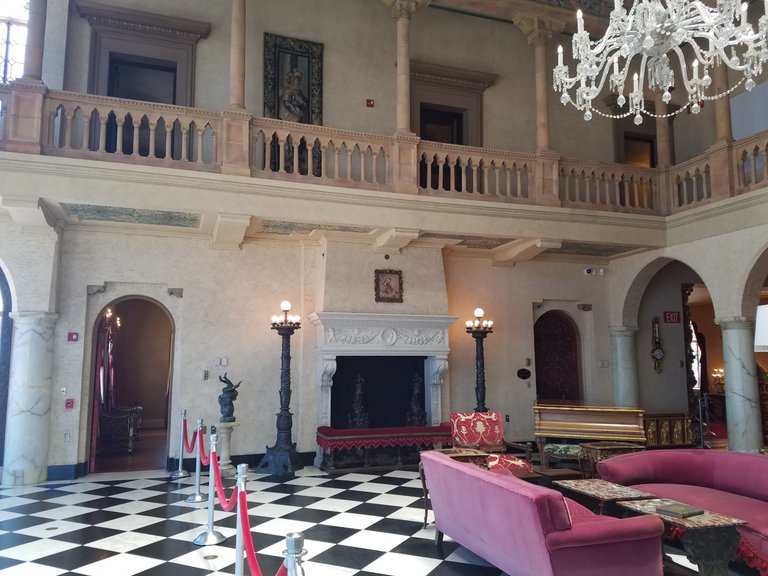
Ceiling of the Great Hall:

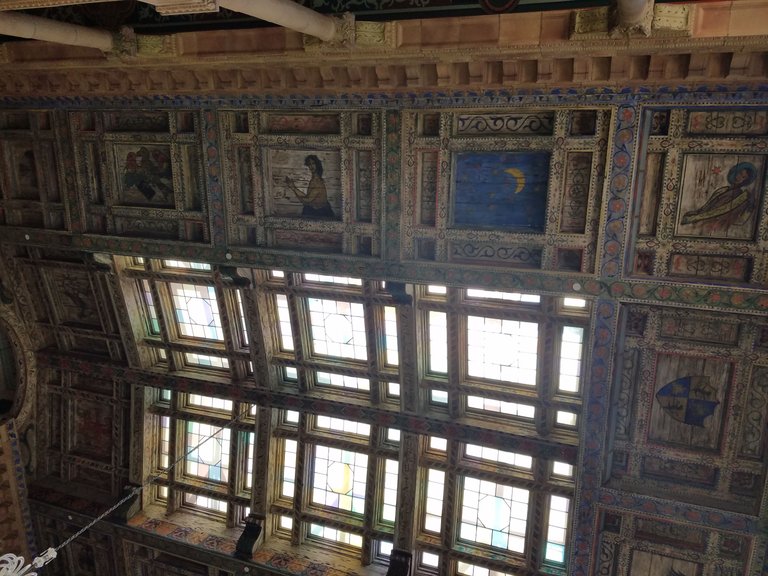
Breakfast Room:
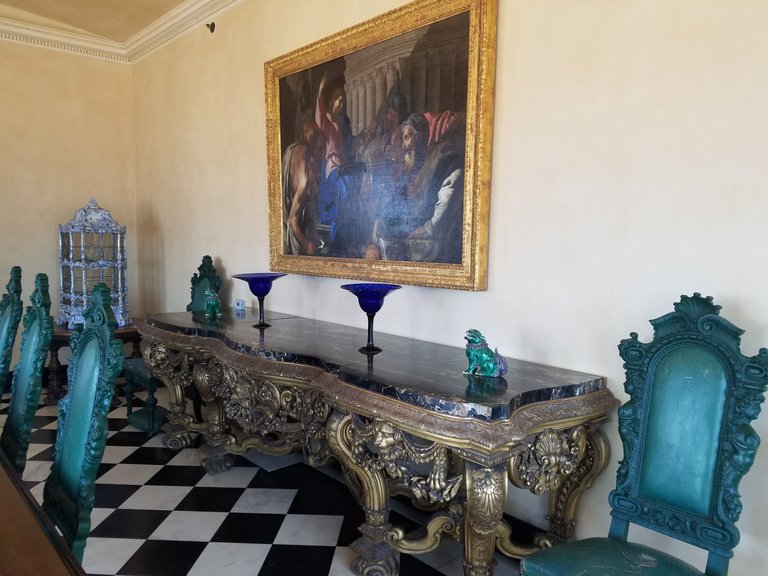
CIRCUS MUSEUM
I love cats, so you may see a disproportionate number of felines, including lions and tigers. I also have a friend who likes hippos so I take pictures of interesting hippos for my friend.
Historical posters:
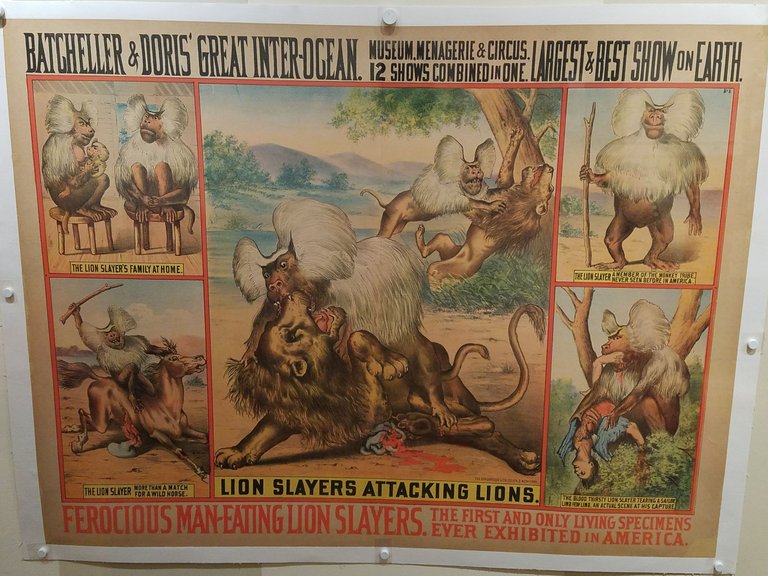
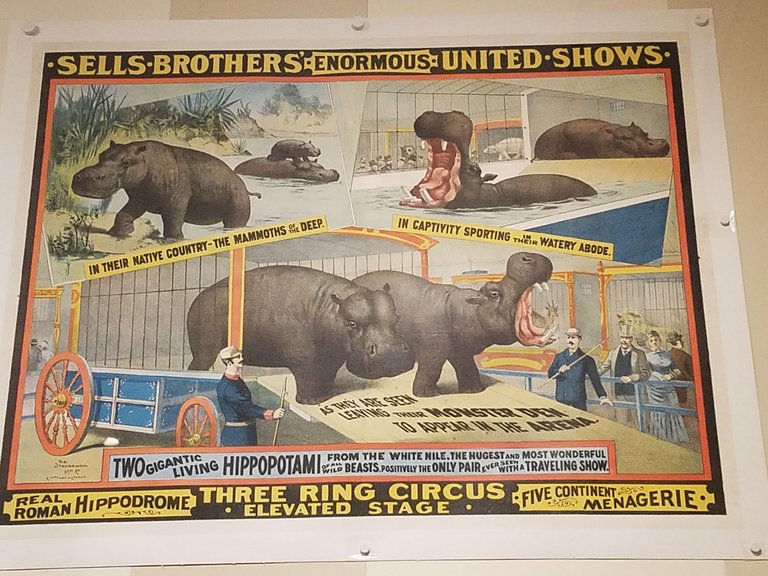

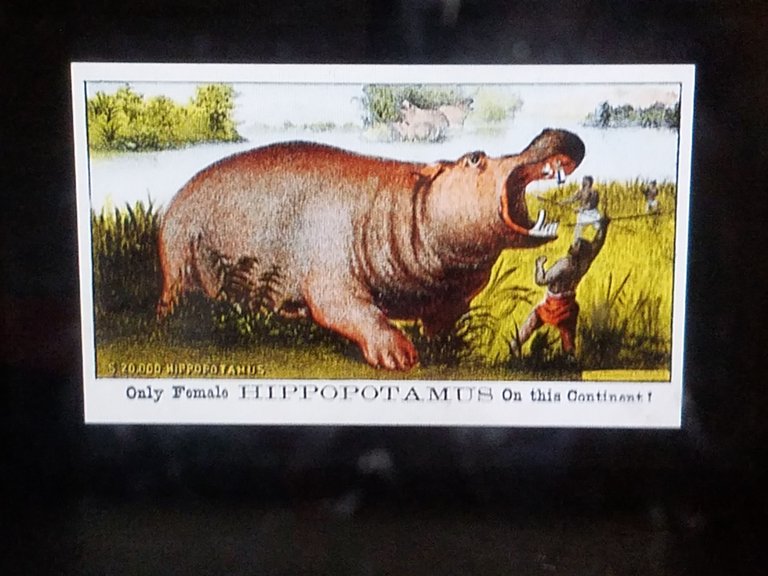
This would not be politically correct nowadays:
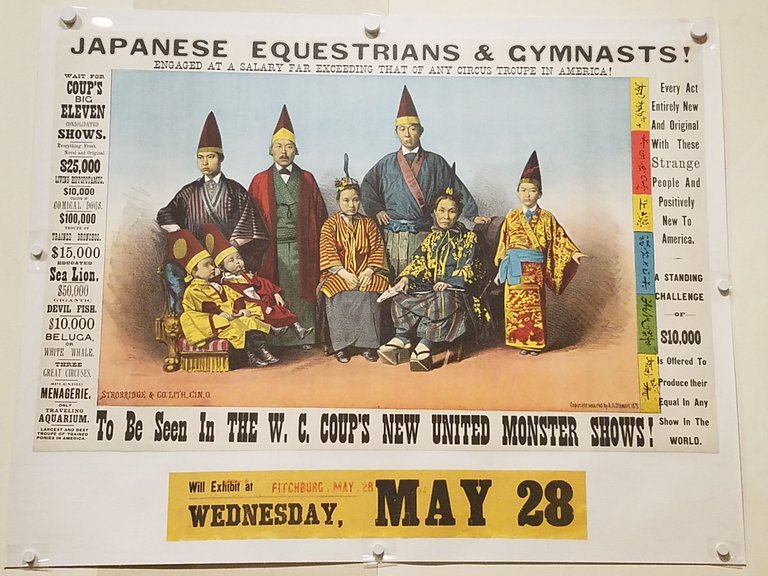
The Circus Museum is housed in two different buildings - the Tibbals Learning Center and the smaller (in terms of content) Historic Galleries. The Historic Galleries include many enormous artifacts including train cars and wagons:
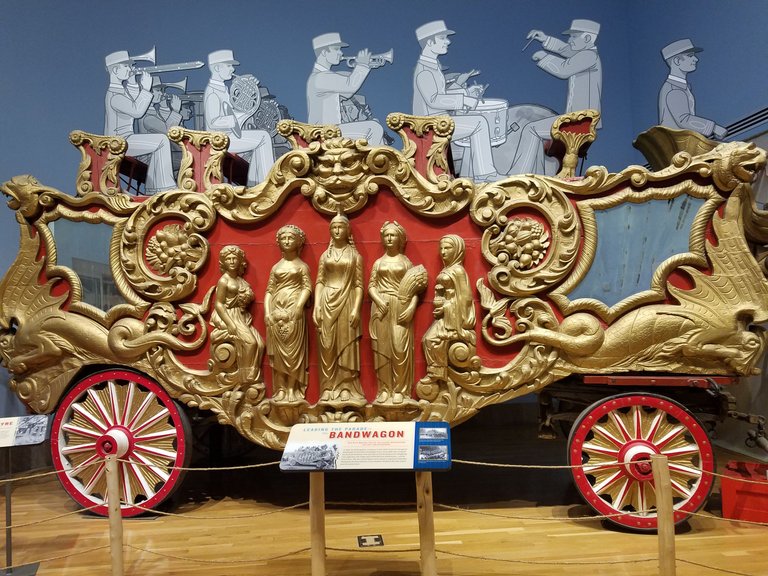
Steam calliope that plays classic circus music:

ROAR!!!
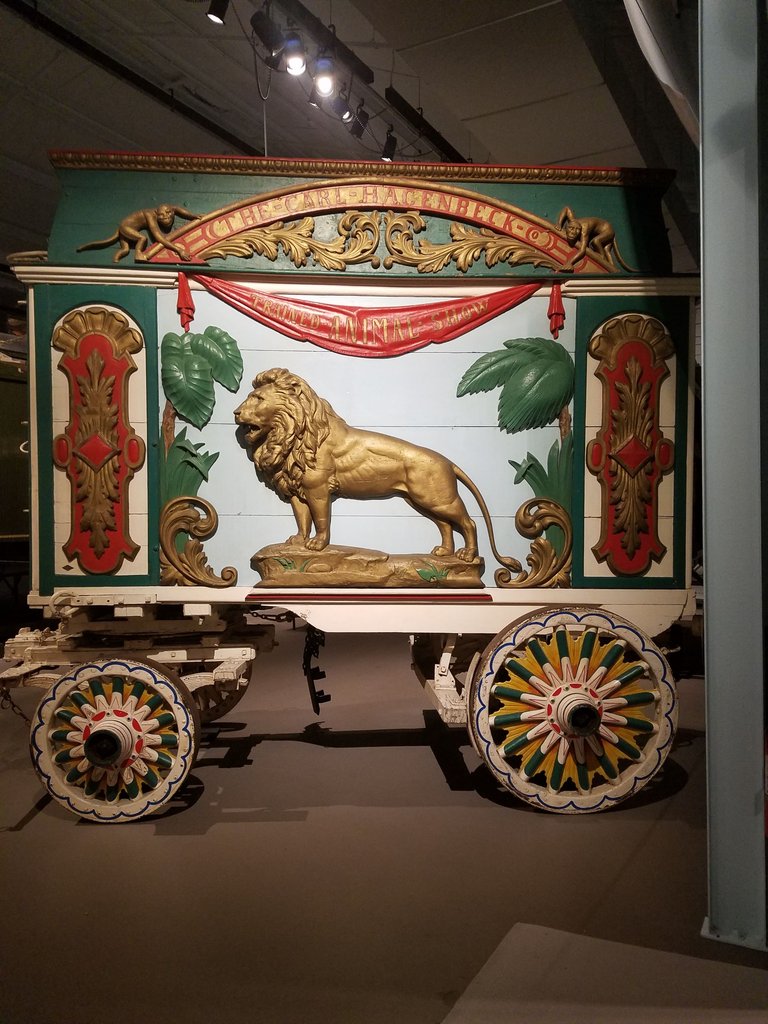
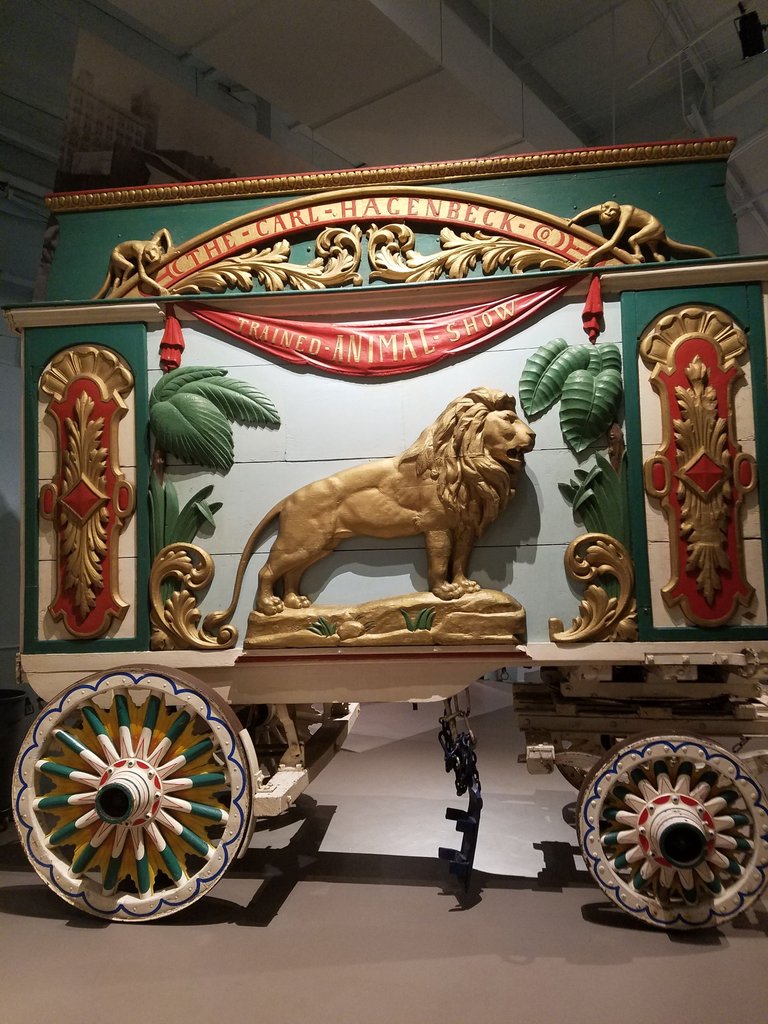
John Ringling's personal train:
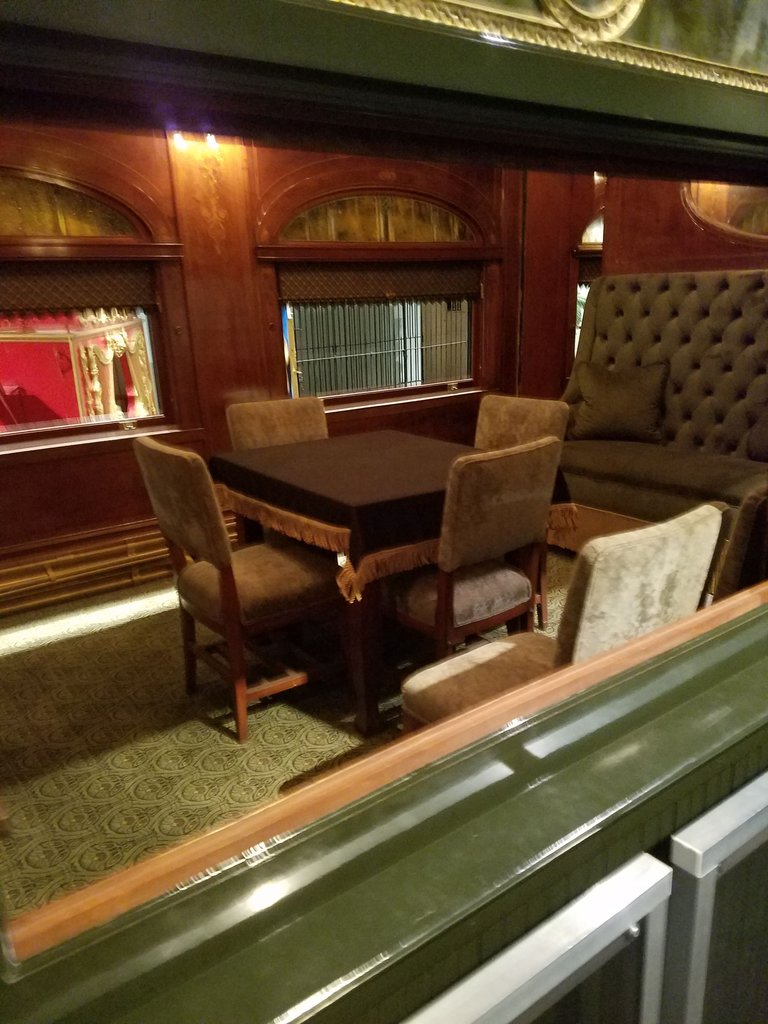
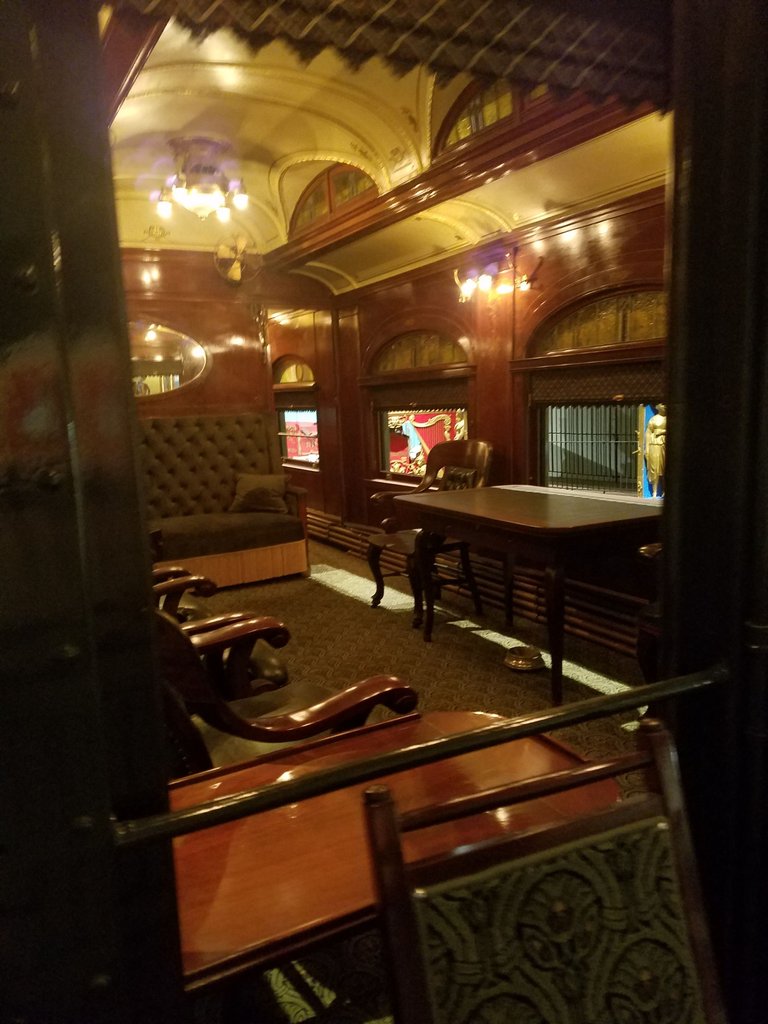
Giant posters advertising the acts:
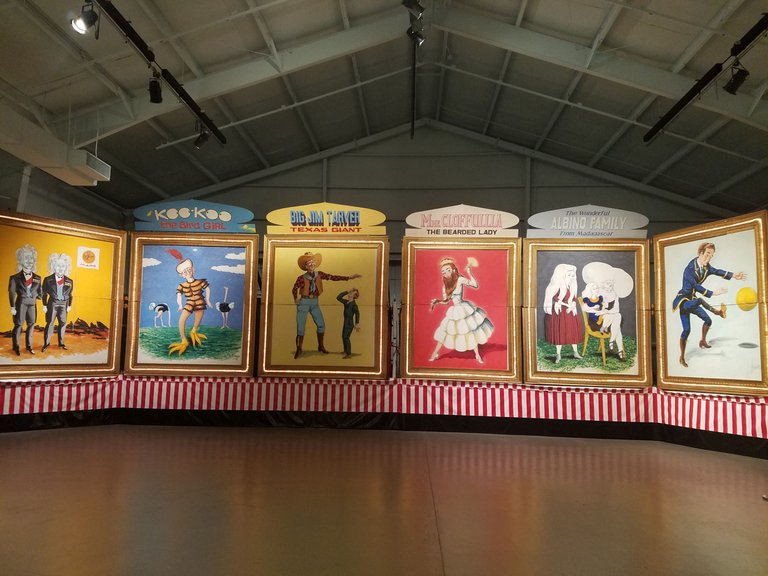
The most prominent attraction at the Tibbals Learning Center is the Howard Bros. Circus Model, which is the world's largest circus model. It is scaled 3/4 inch to 1 foot, features more than 45,000 pieces and is 3,800 square feet in size. This was the life work of Howard C. Tibbals who spent over 50 years sculping the pieces.
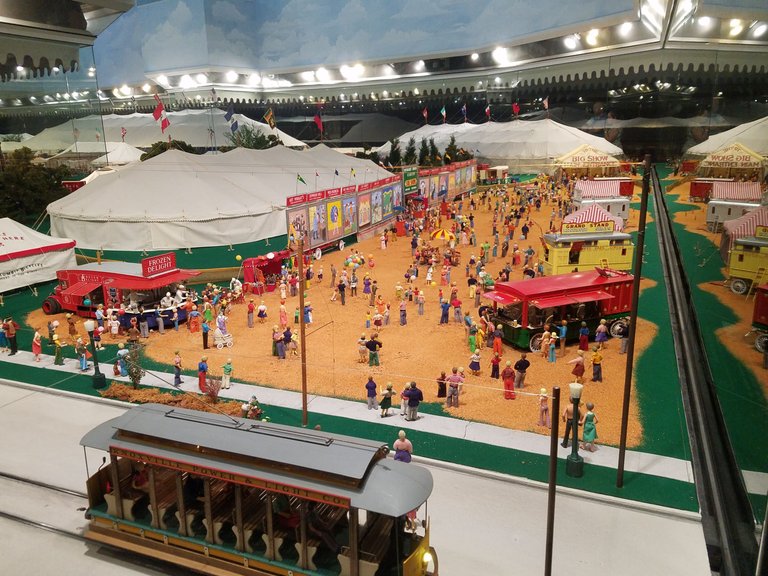
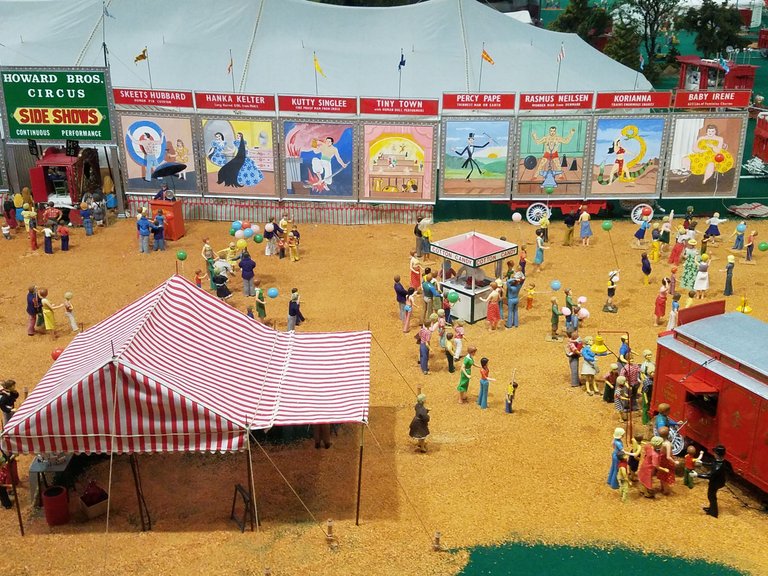
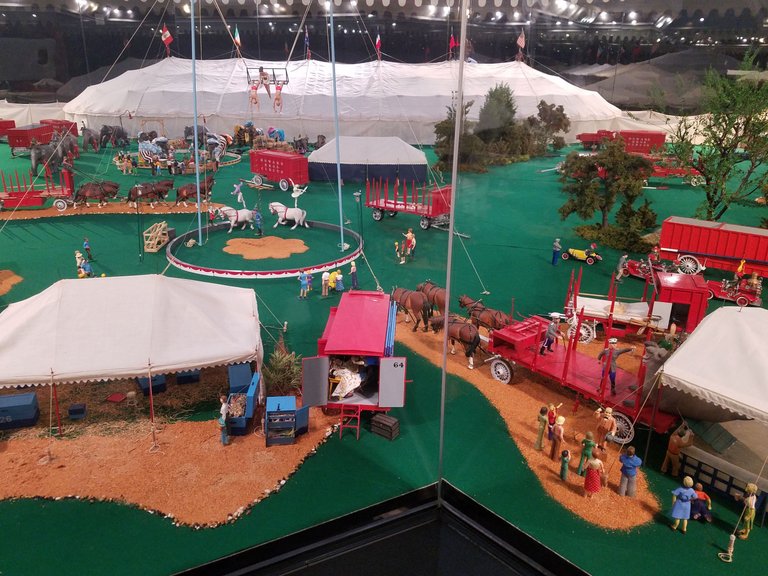

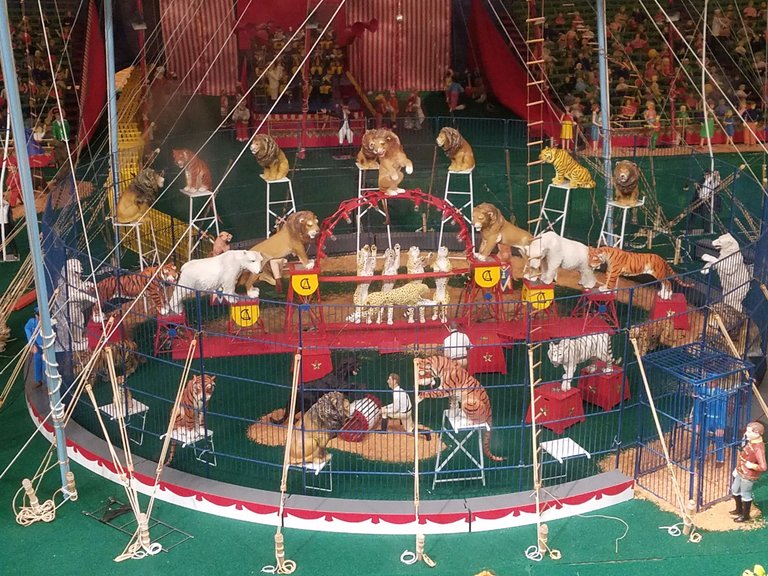
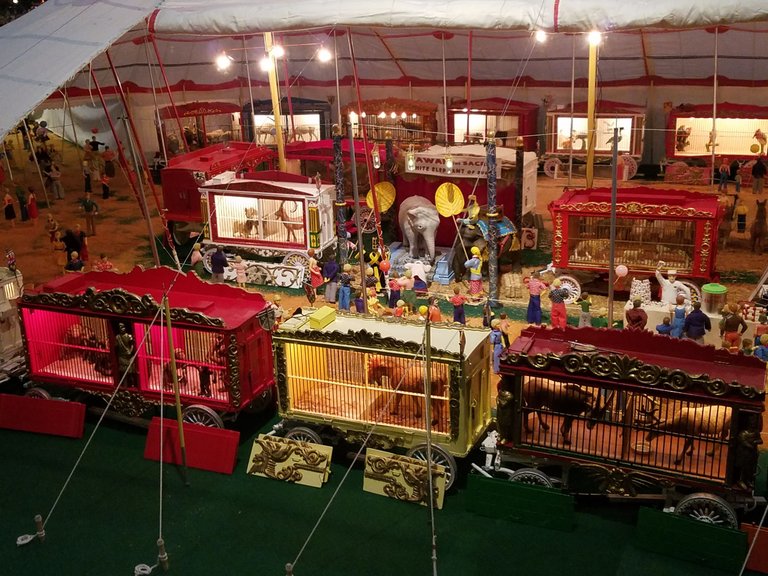
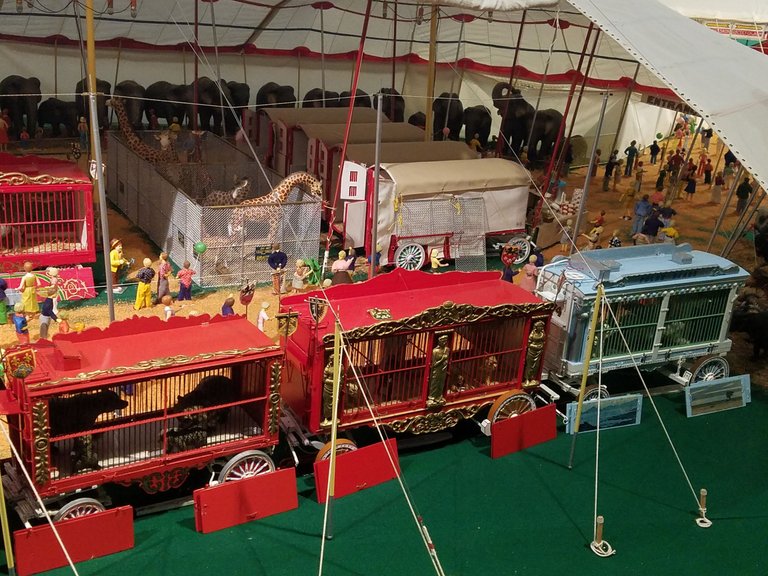
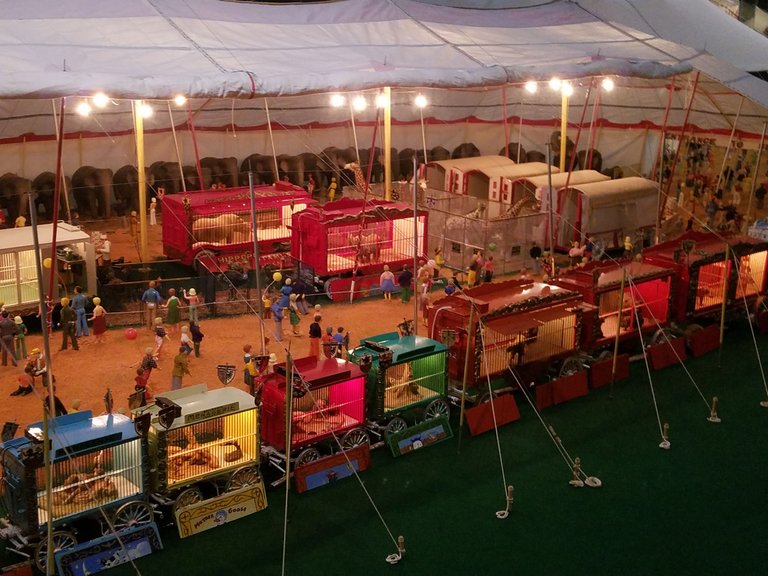
Here is a downward view of the model circus from the second floor:
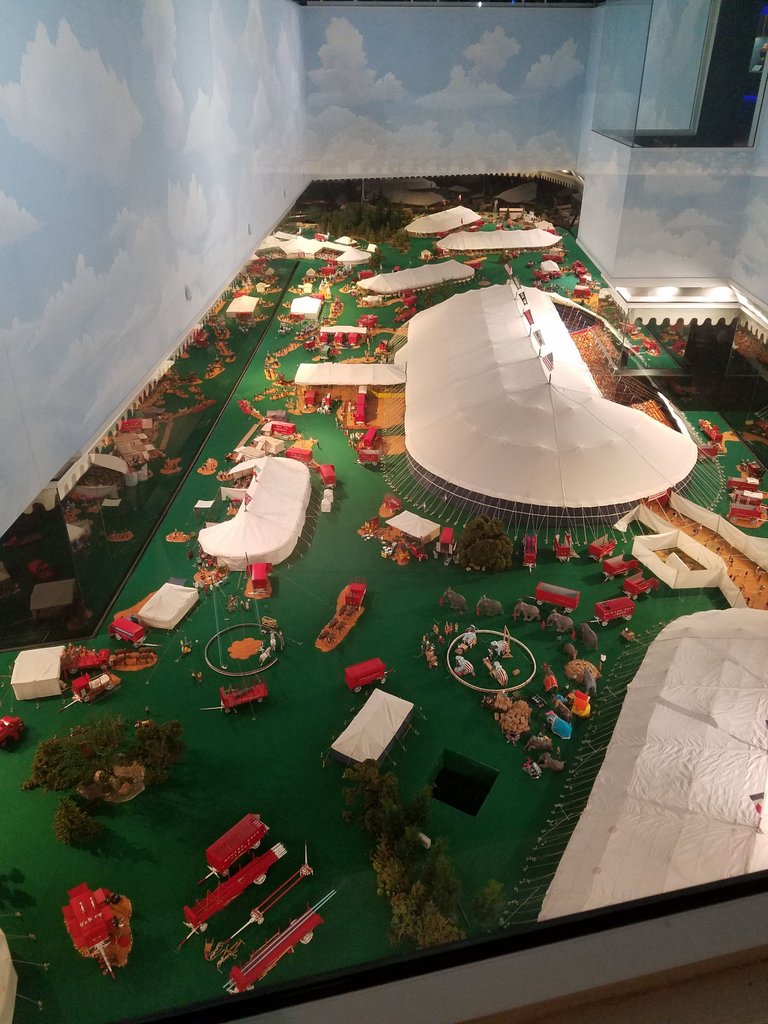
Here are some of the other eye-catching exhibits found at the Tibbals Learning Center.
These are some circus related toys from past eras:
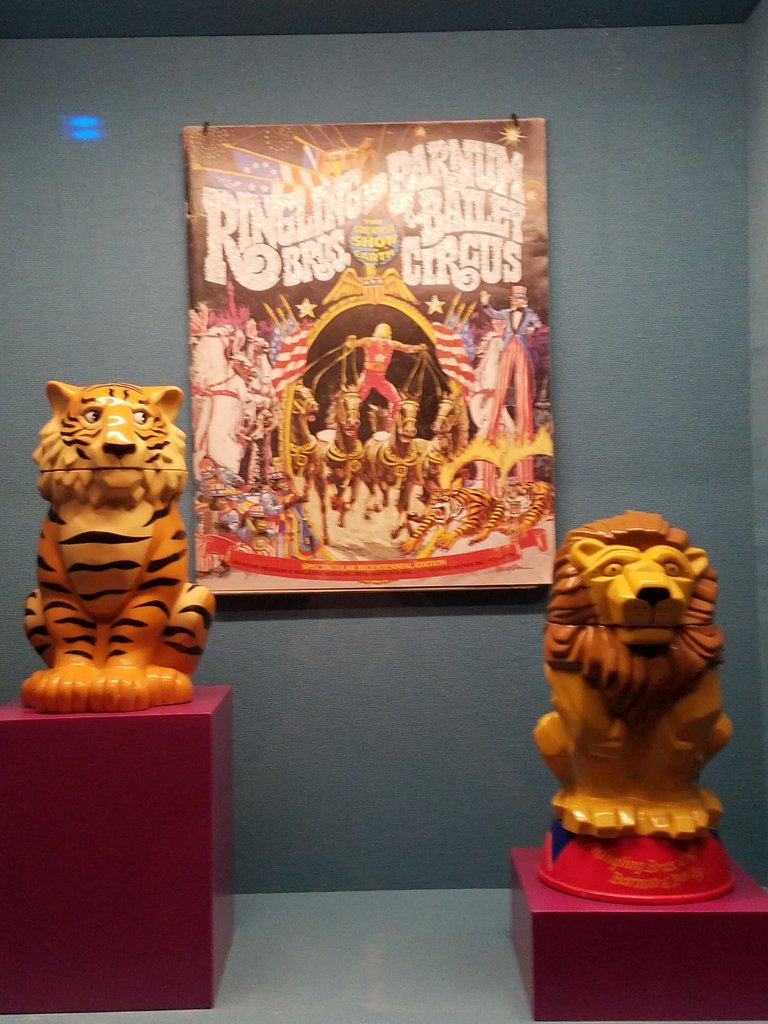
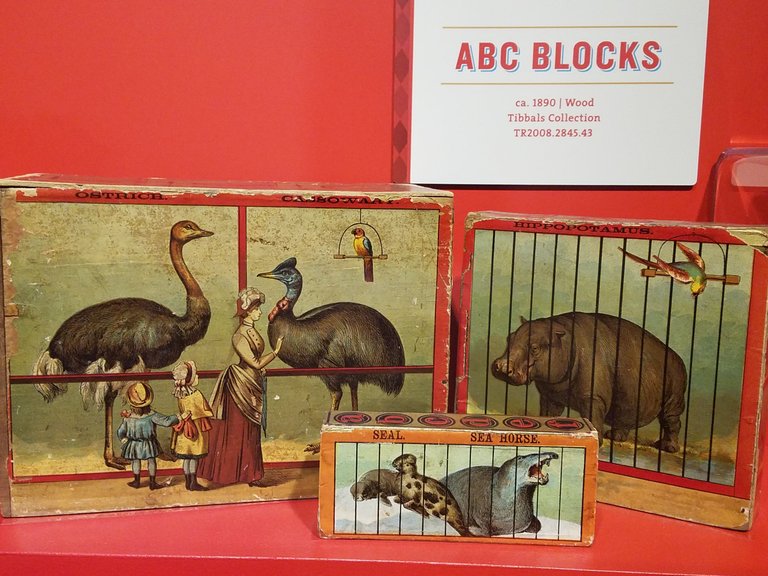
This Puss In Boots gown was designed for the "Toyland" Spec by Don Foote for the 109th edition of the Ringling Brothers and Barnum & Bailey Circus in 1979:
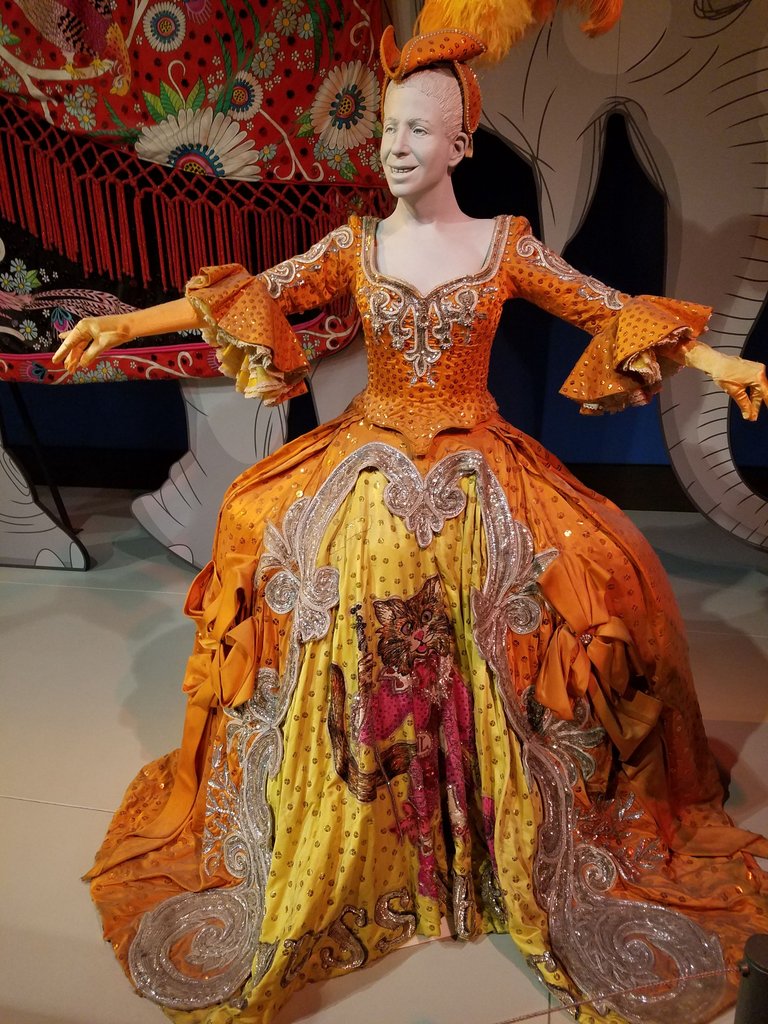
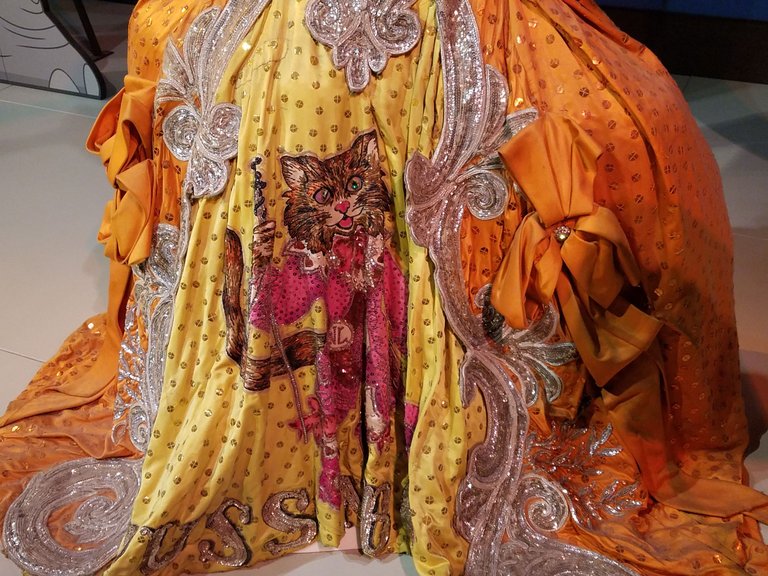
ROAR!!!
In the background, you can see the Puss In Boots gown, along with an elephant blanket for the Gunther Gebel-Williams Farewell Tour. Gunther was a famous animal trainer known for training elephants and TIGERS!
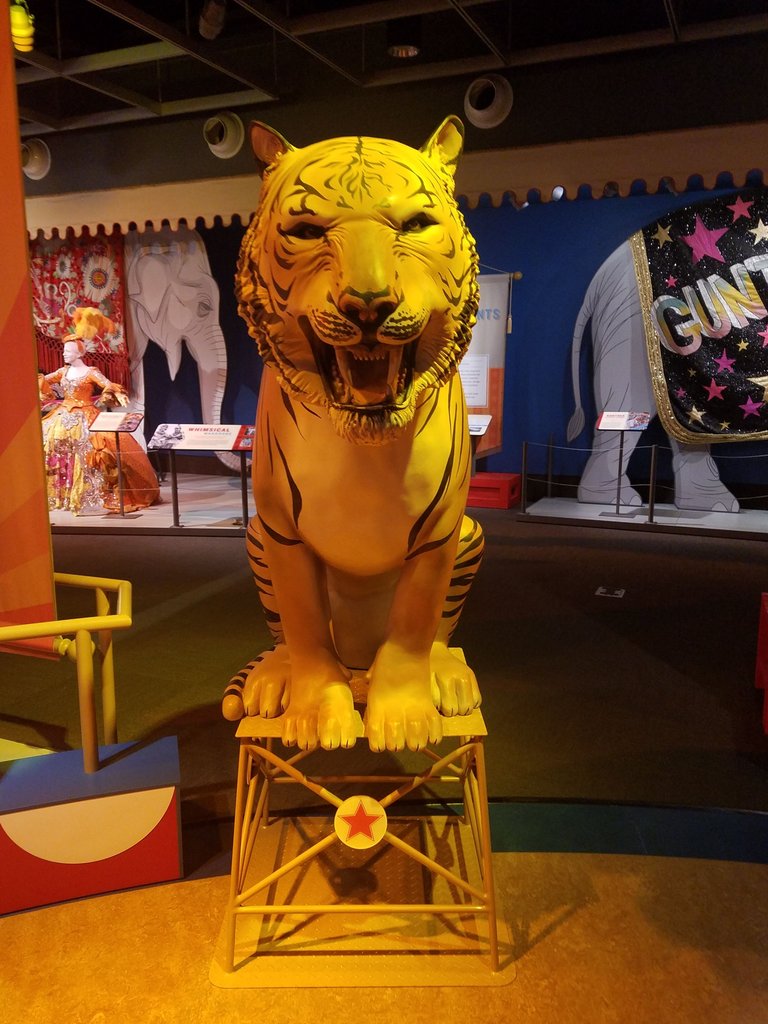
White Model Pieces, 146th Edition
Out of This World, 2016
For each new edition of the circus, every scenic element and cast member, including the animals, are represented in miniature in the production team's white model. By playing out scenes with the model, the production team can troubleshoot challenges, maximize the use of rehearsal time, and communicate the scope of the production to the
broader company.
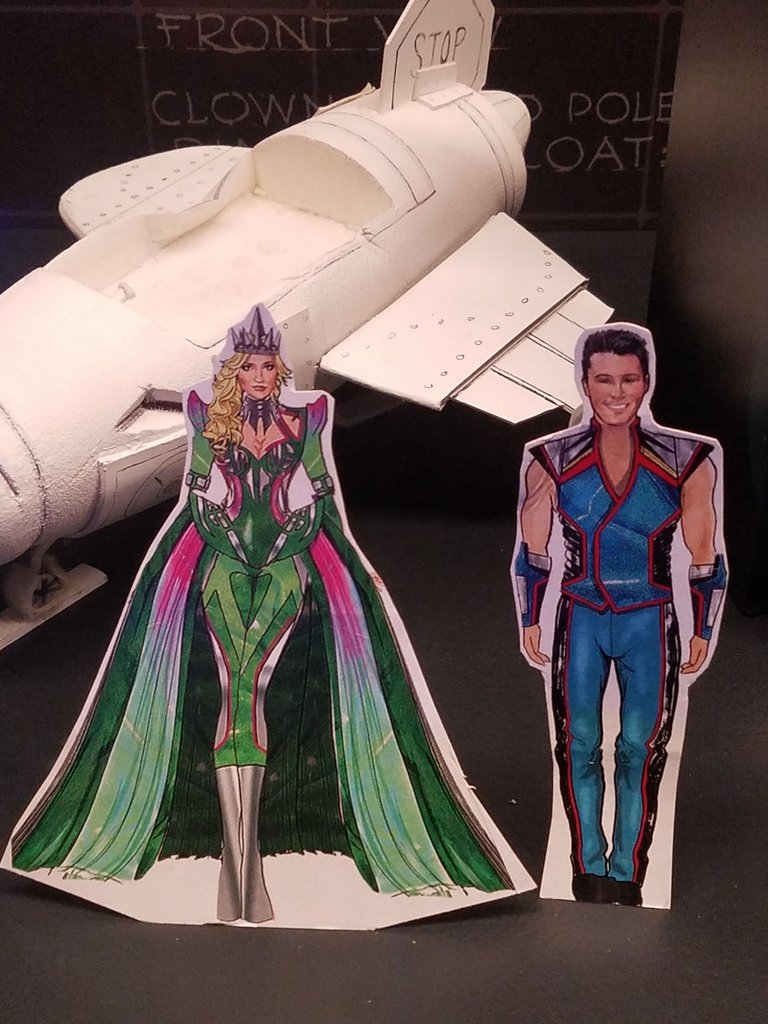
Here you can see the sketch and actual costume of Alex Lacey for the Out of This World edition.
Alexander Lacey is a world-renowned big cat trainer who worked with lions, tigers, and leopards. Nowadays, you can visit Alex and his retired cats at the Krone Farm in Weßling in southern Germany (Bavaria):
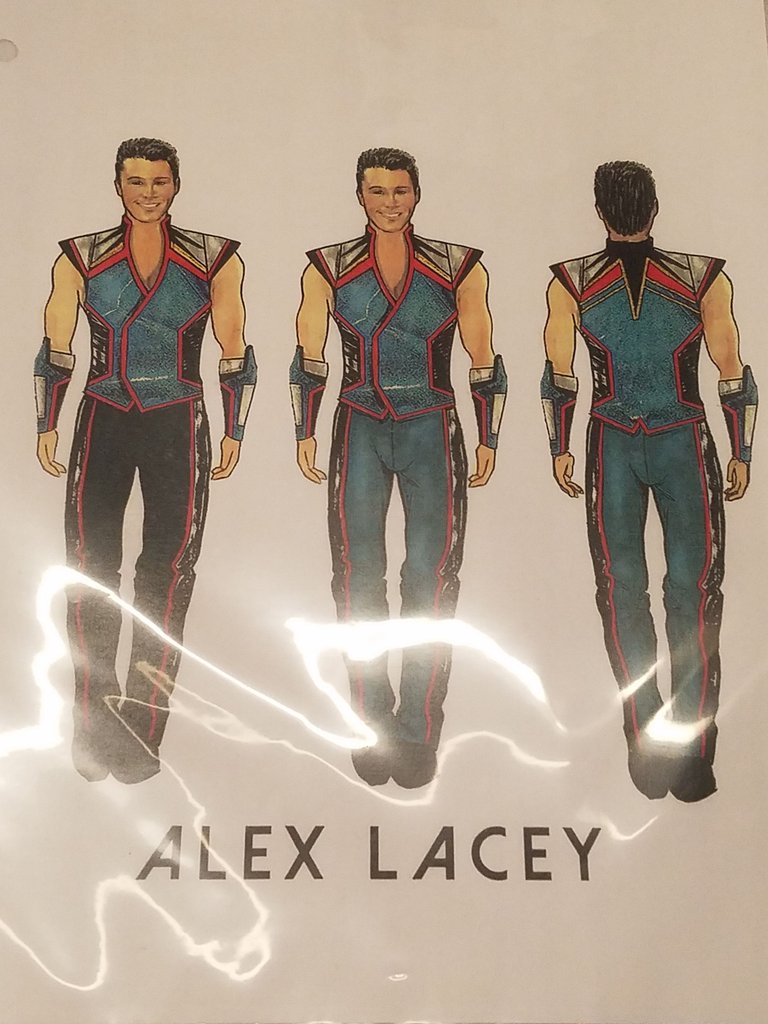
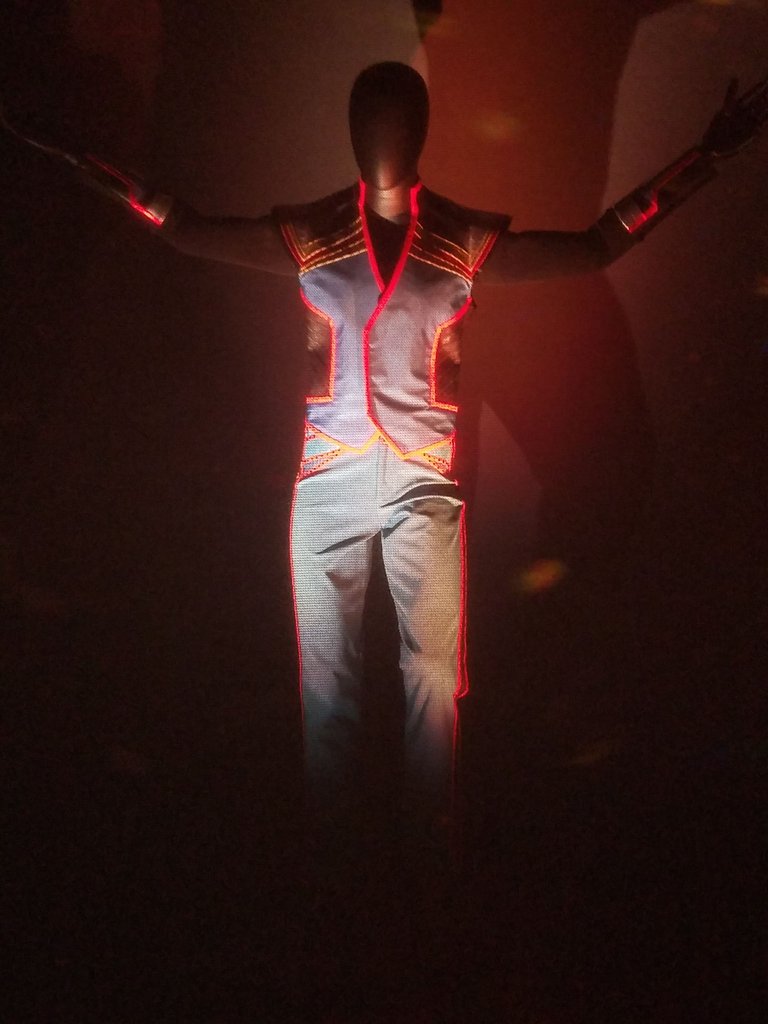
GIFT SHOP
Note that I am not compensated in any way for promoting any of these products. I just like to take note of cute things!
The Ringling Gift Shop has a variety of cute souvenirs for the ailurophiles out there, particularly maneki-neko (luck cats). And for the doggo lovers, there are some adorable Shiba Inu trinkets as well.
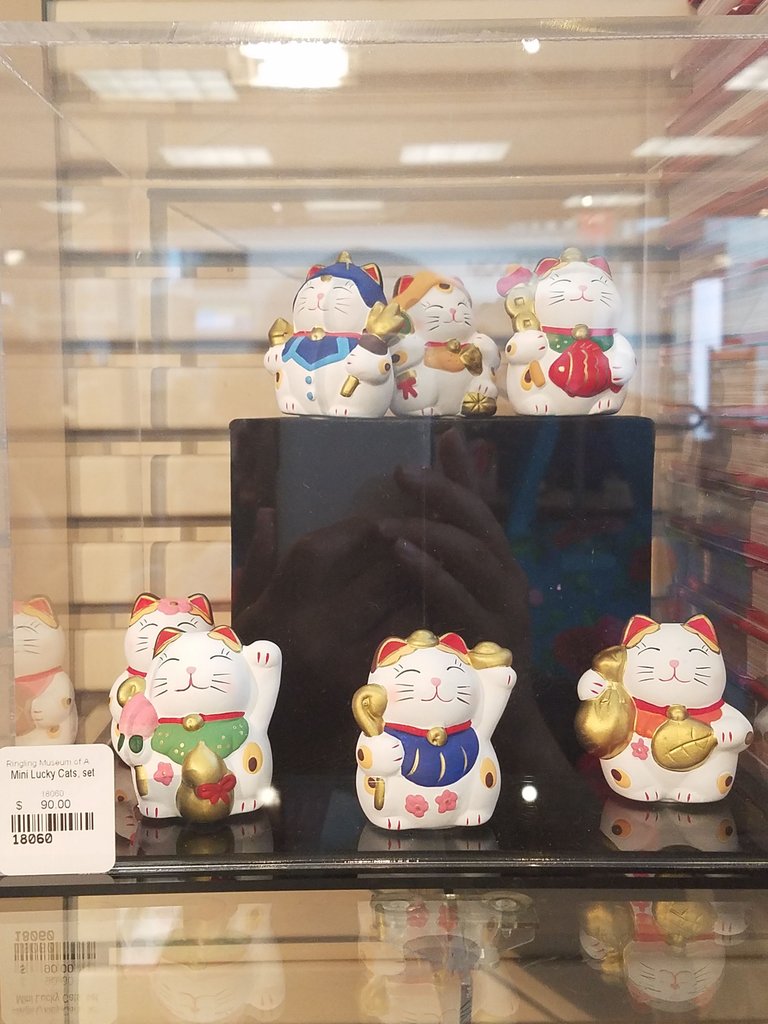
Fortune Cat Mug White
by Miya Company
$15
https://www.miyacompany.com/113-090-113-090
Japanese Small Plate Set Ceramic Cute Cats
$13.55
https://www.amazon.com/Japanese-ceramic-design-appetizer-dessert/dp/B07NKYL2J7
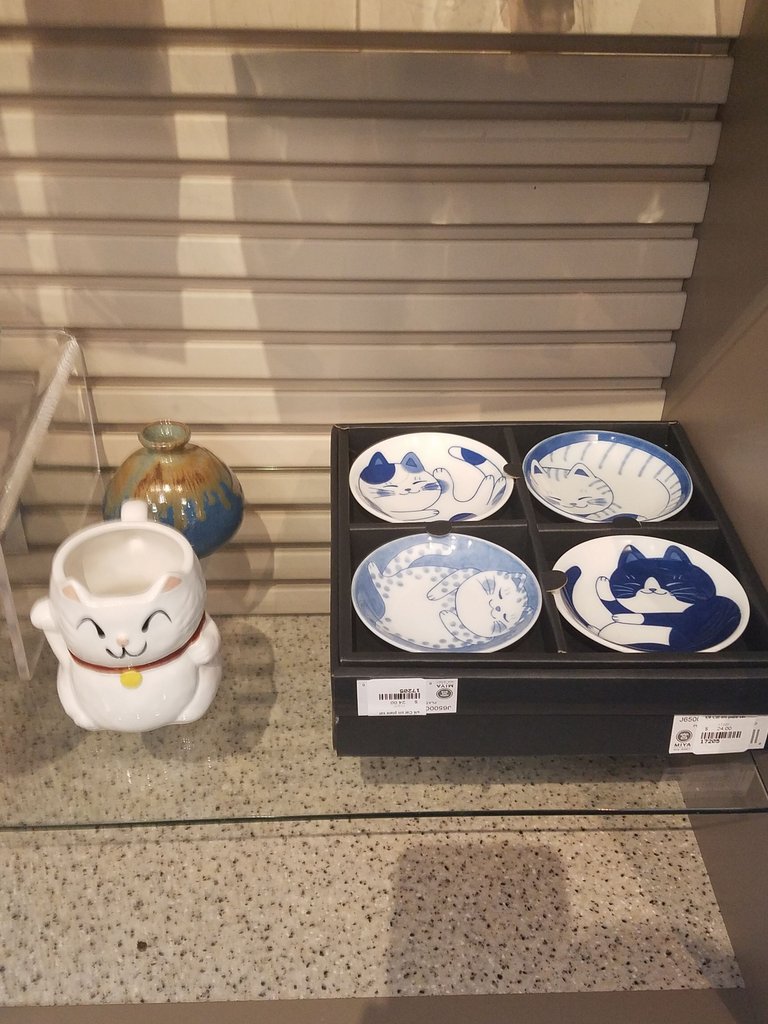
Lucky Cat Bookmark
$14.95
https://janmstore.com/products/lucky-cat-bookmark
The Dancing Geisha Cat Metal Bookmark
$15
https://davidhowell.com/products/the-dancing-geisha-cat-bookmark
Petty cat, Standing cat displayed on The Glass Surface Cute Figurine (Tora)
$70
https://www.amazon.com/Petty-Standing-displayed-Surface-Figurine/dp/B09QXHMB69
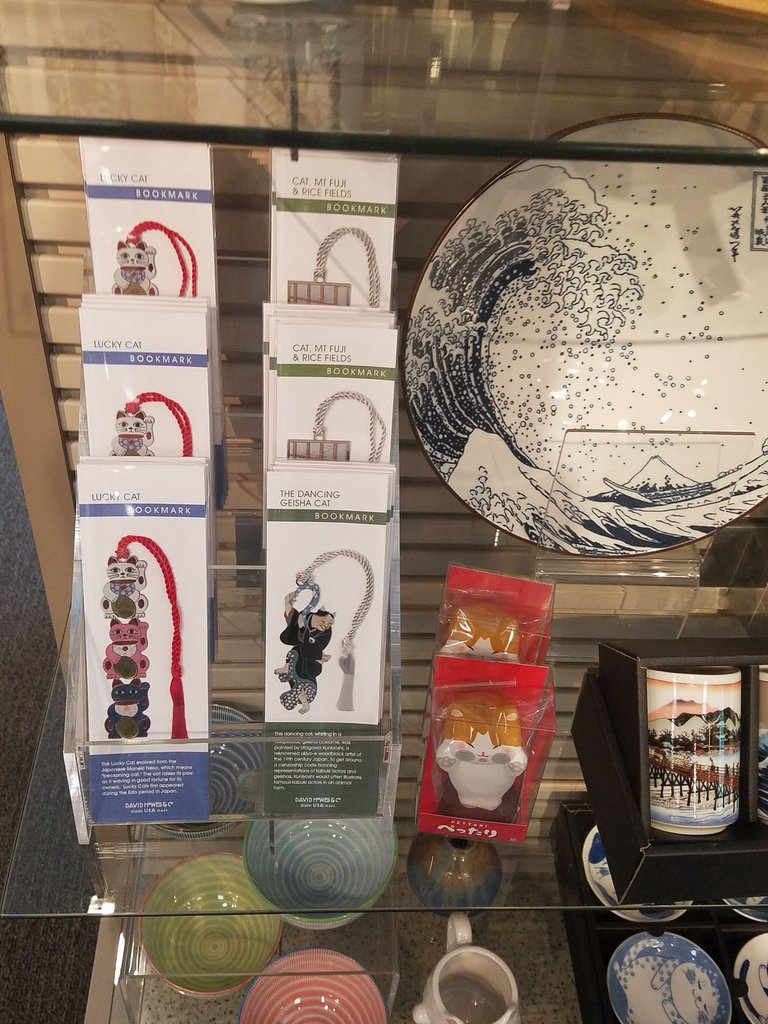
Lucky Maneki Neko Sushi Teacup
by Setomonohonpo
1 for $12
https://www.frogandtoadstore.com/maneki-neko-cats-ceramic-cup.html
Teacup Japanese Dogs
$11 - $15, but sold out on many sites
https://www.miyacompany.com/114-889-114-889
https://www.ebay.com/itm/142027892598
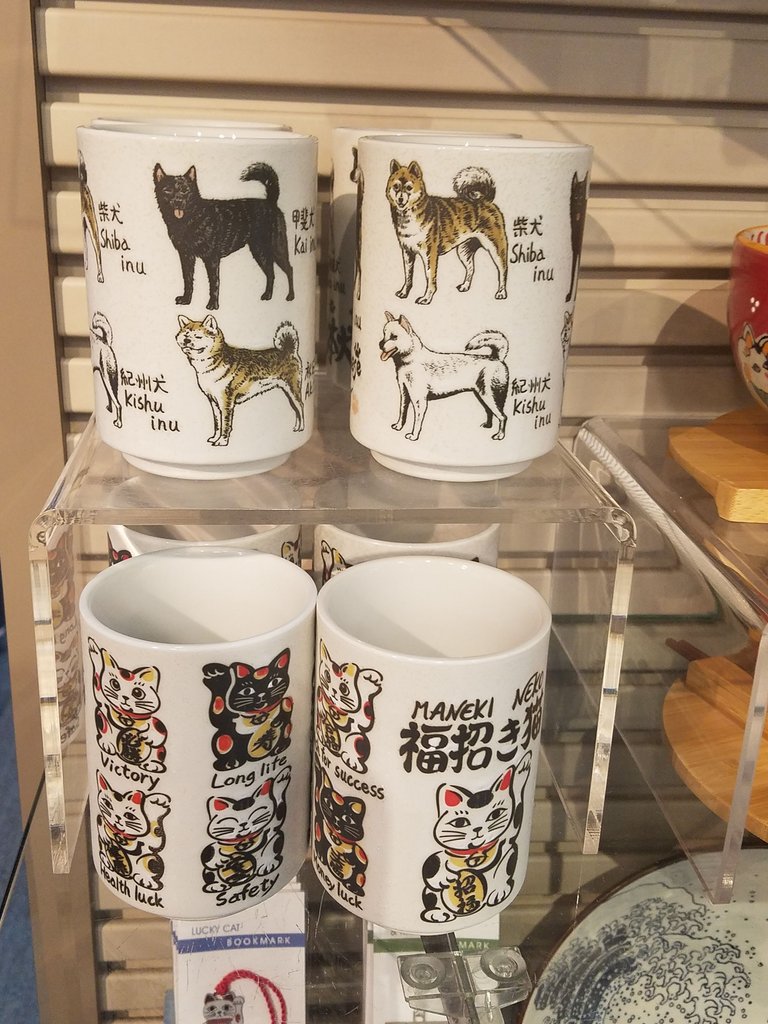
Red Lucky Cat Bowl With Wooden Lid and Trivet Set
Currently Sold Out (normally $56)
https://sippingstreams.com/products/red-lucky-cat-bowl-with-wooden-lid-and-trivet-set
But there is a similar bowl (except that it has notches for chopsticks):
Lucky Cat Japanese Maneki Neko Red Porcelain Ramen Soup Bowl With Chopsticks Set
$19.95
https://www.walmart.com/ip/Lucky-Cat-Japanese-Maneki-Neko-Red-Porcelain-Ramen-Soup-Bowl-With-Chopsticks-Set/626148206
Home Cup Dog Mug Cup
by Biudeco
$23.89
https://www.amazon.com/BIUDECO-Creative-Ceramic-Coffee-Drinking/dp/B0CW3MCGF2
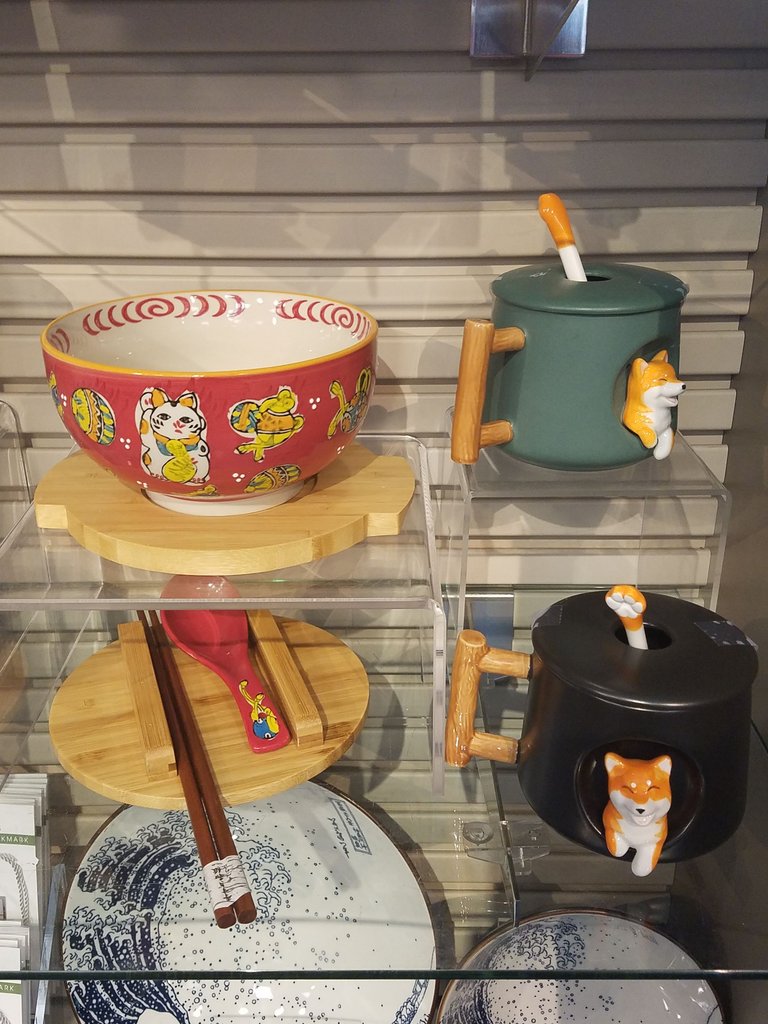
I was hoping the Gift Shop would have lots of cute circus-themed plushies. Alas, this was all I could find and they seem to be high-end and expensive.
Mark Roberts Circus Monkey
MSRP: $93.95
https://www.markrobertswholesale.com/product/circus-monkey15-5/
Mark Roberts Glitter Monkey
MSRP: $156.95
https://www.markrobertswholesale.com/product/glitter-monkey-17-5/

Mark Roberts Giraffe with Saddle
MSRP: $439.95
https://www.markrobertswholesale.com/product/giraffe-w-saddle-37/
Mark Roberts Balancing Act Monkey
MSRP: $89.95
https://www.markrobertswholesale.com/product/balancing-act-monkey-22-a2/
